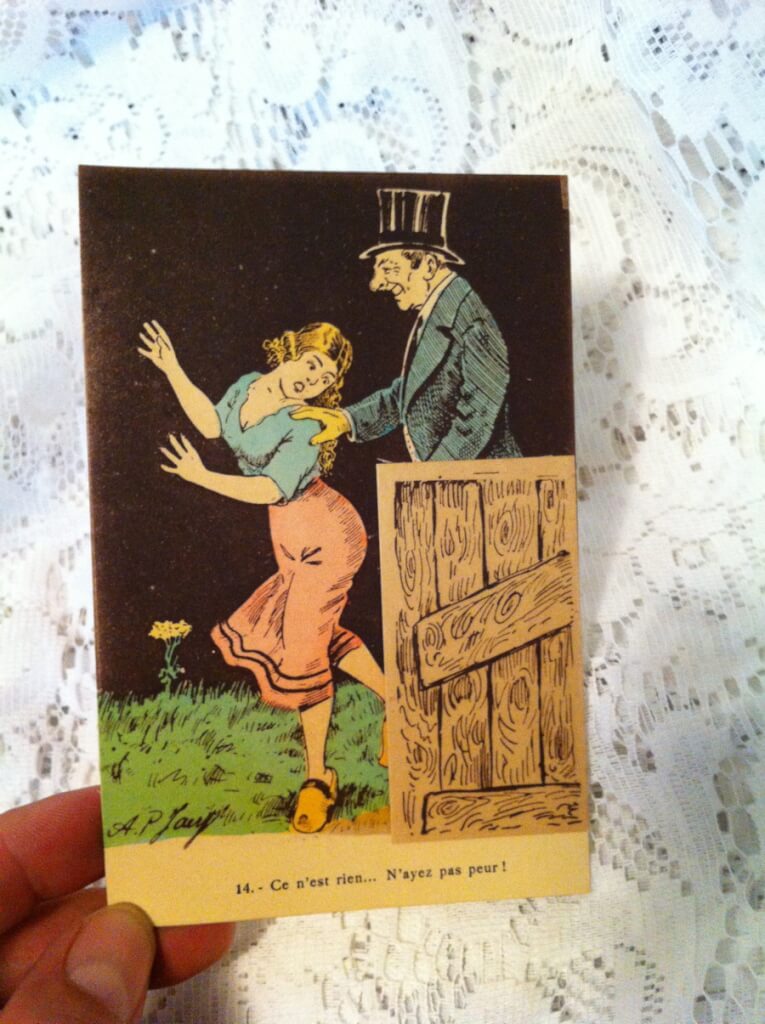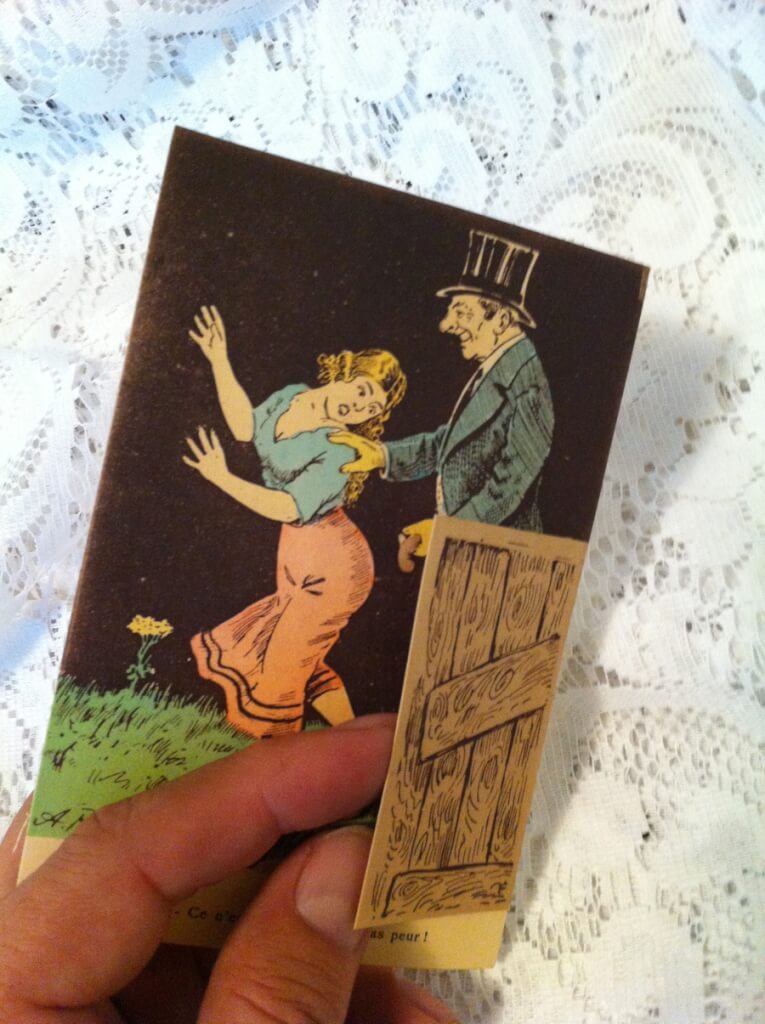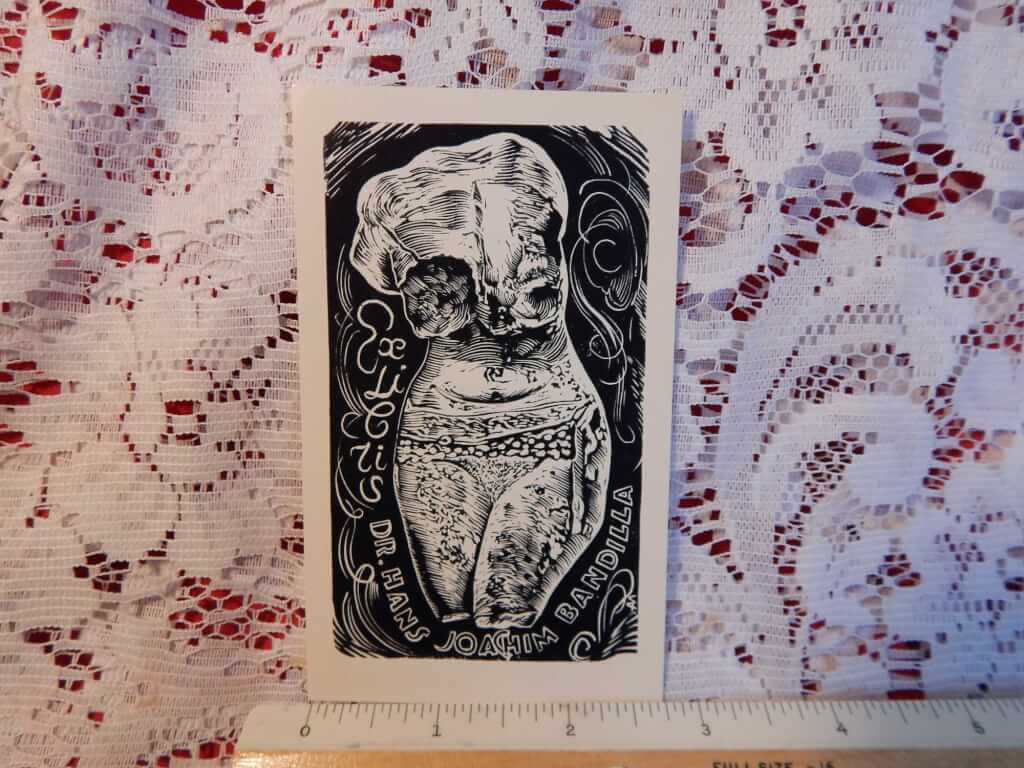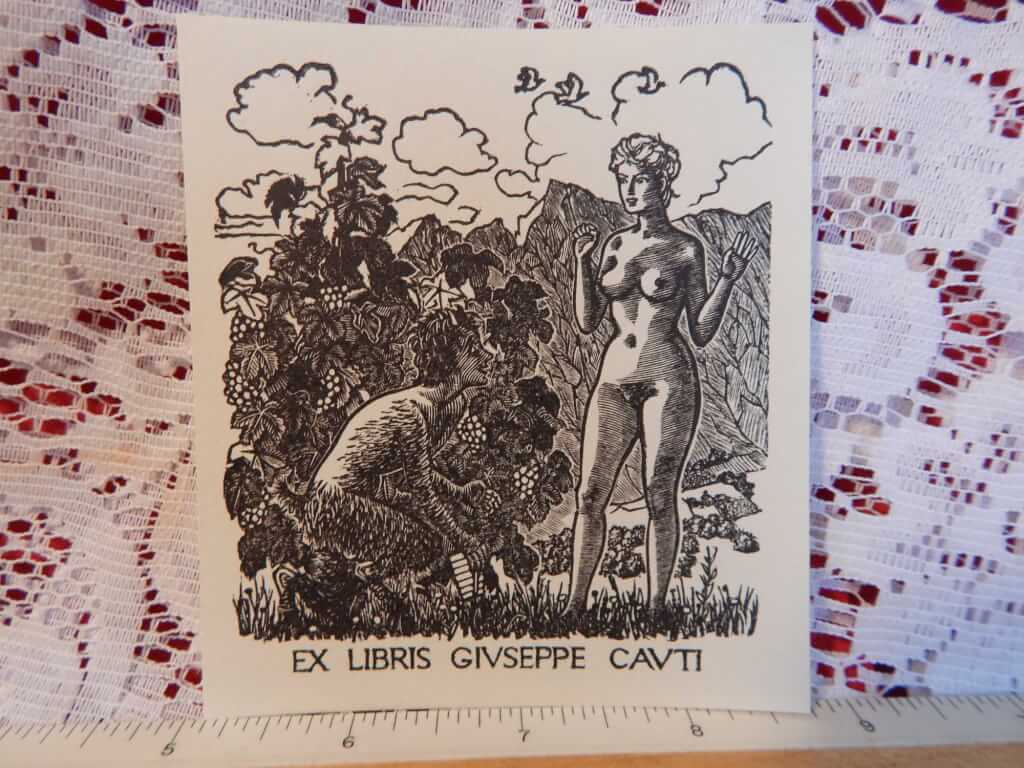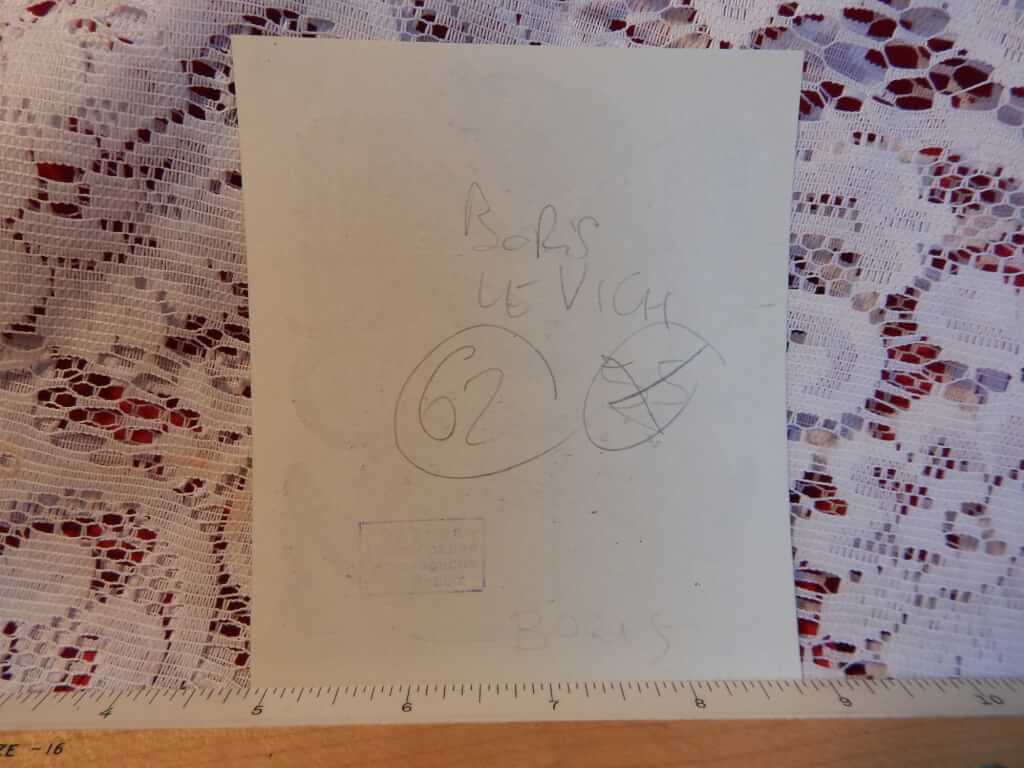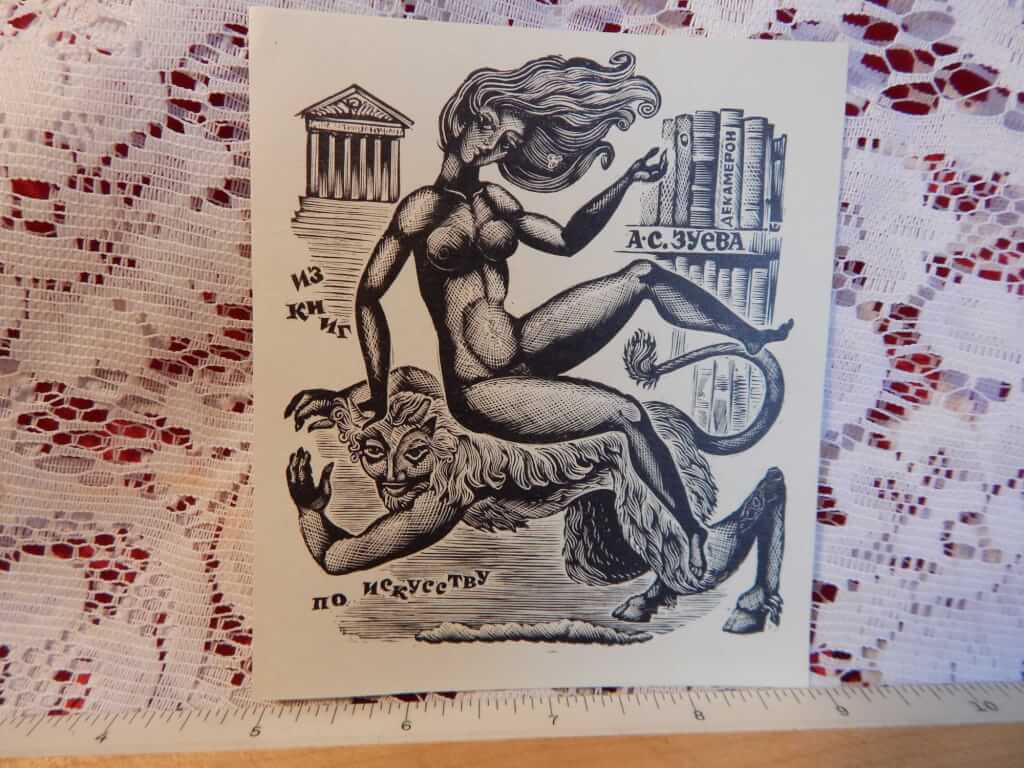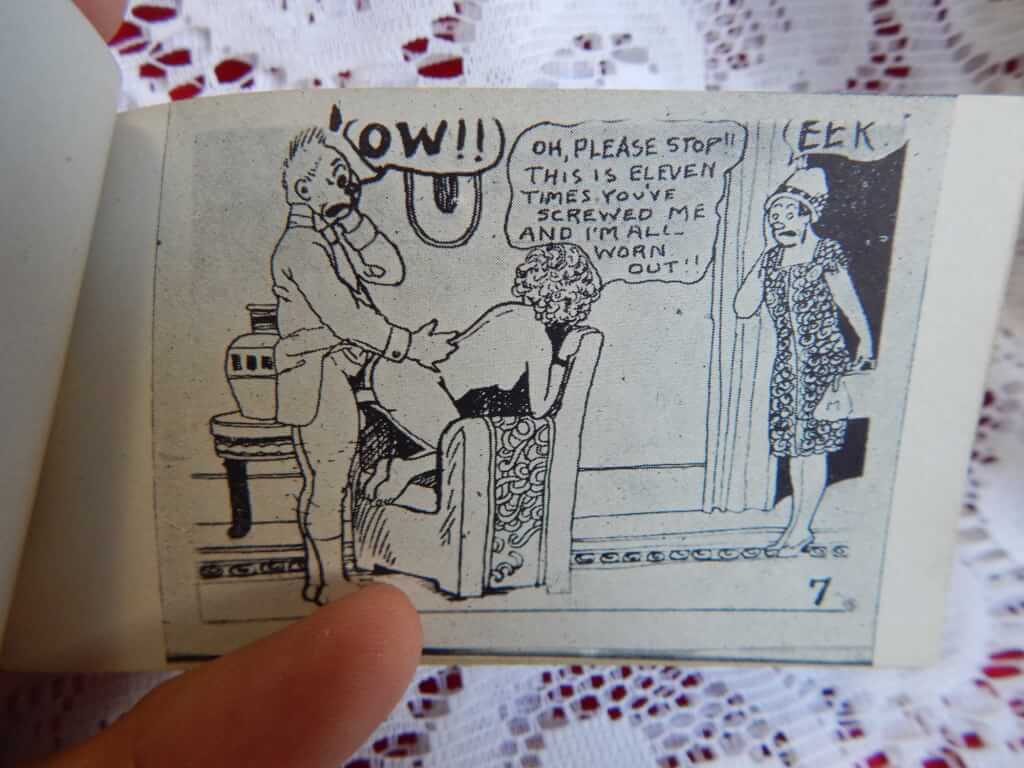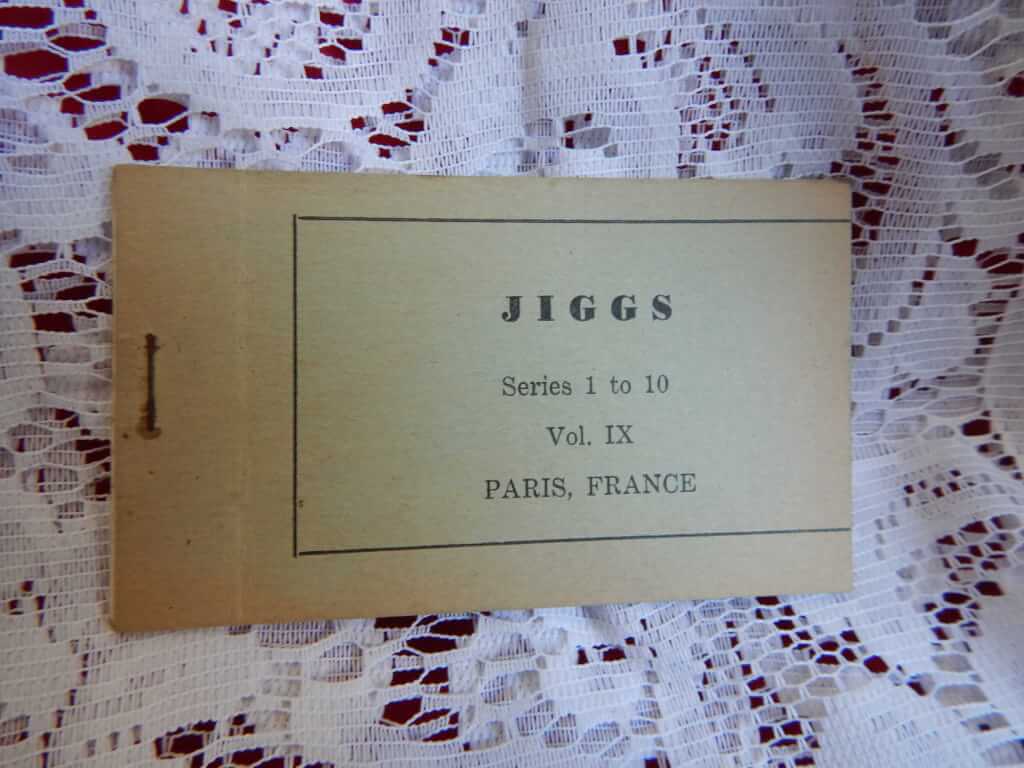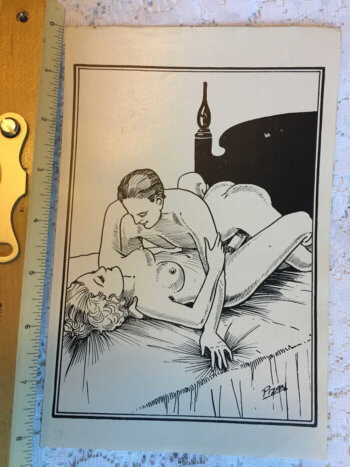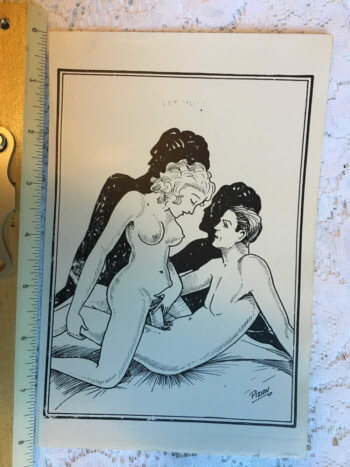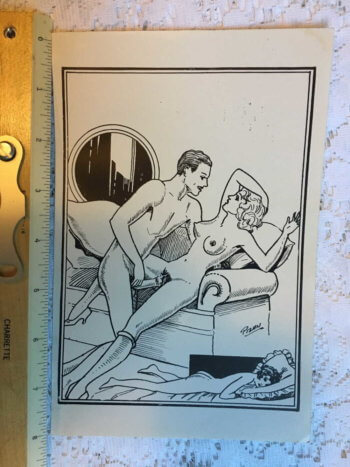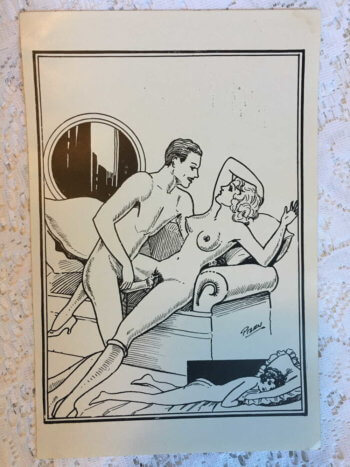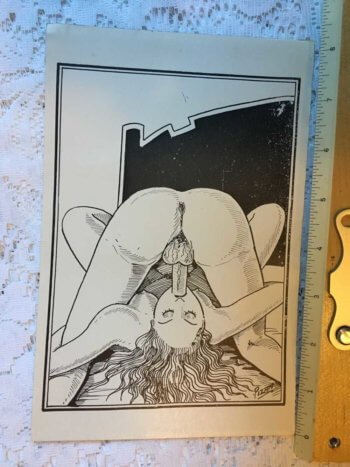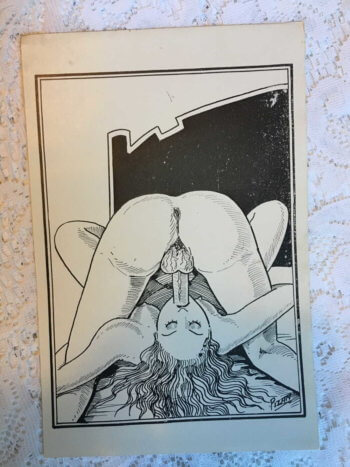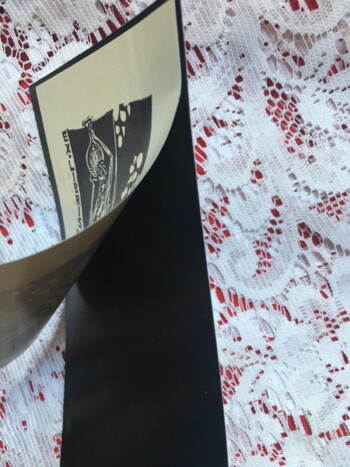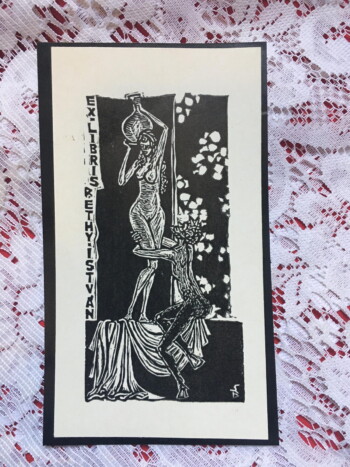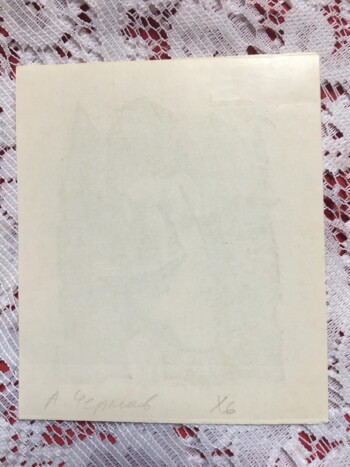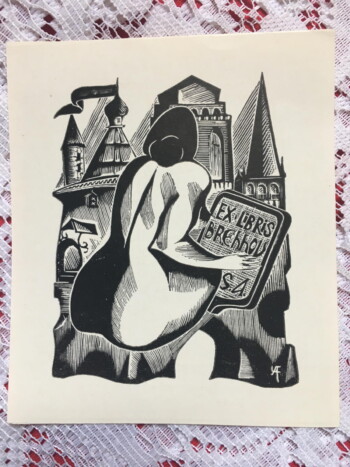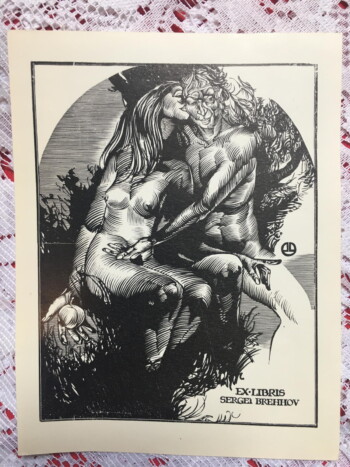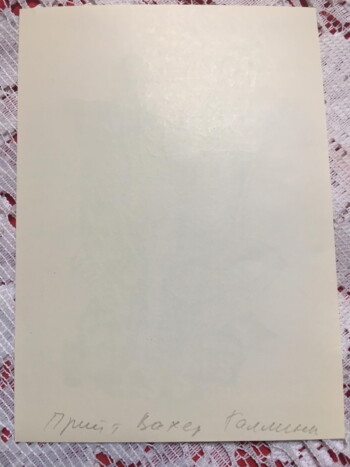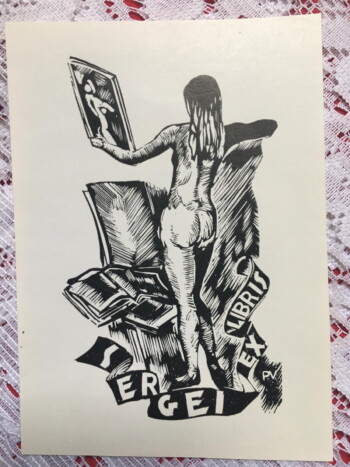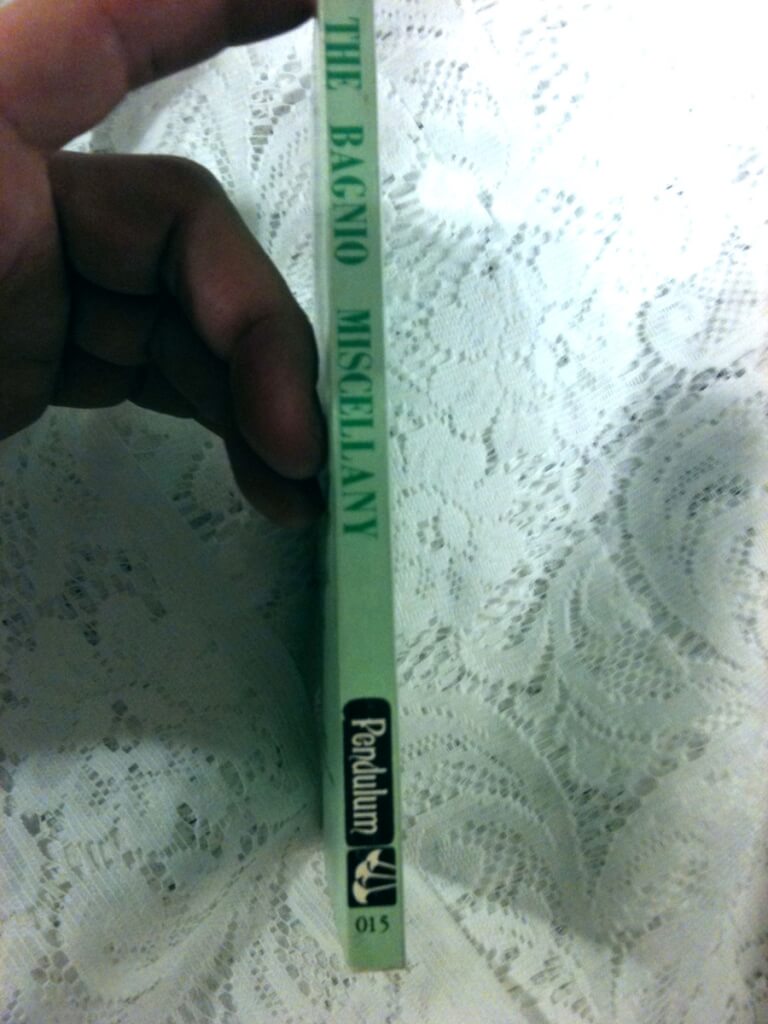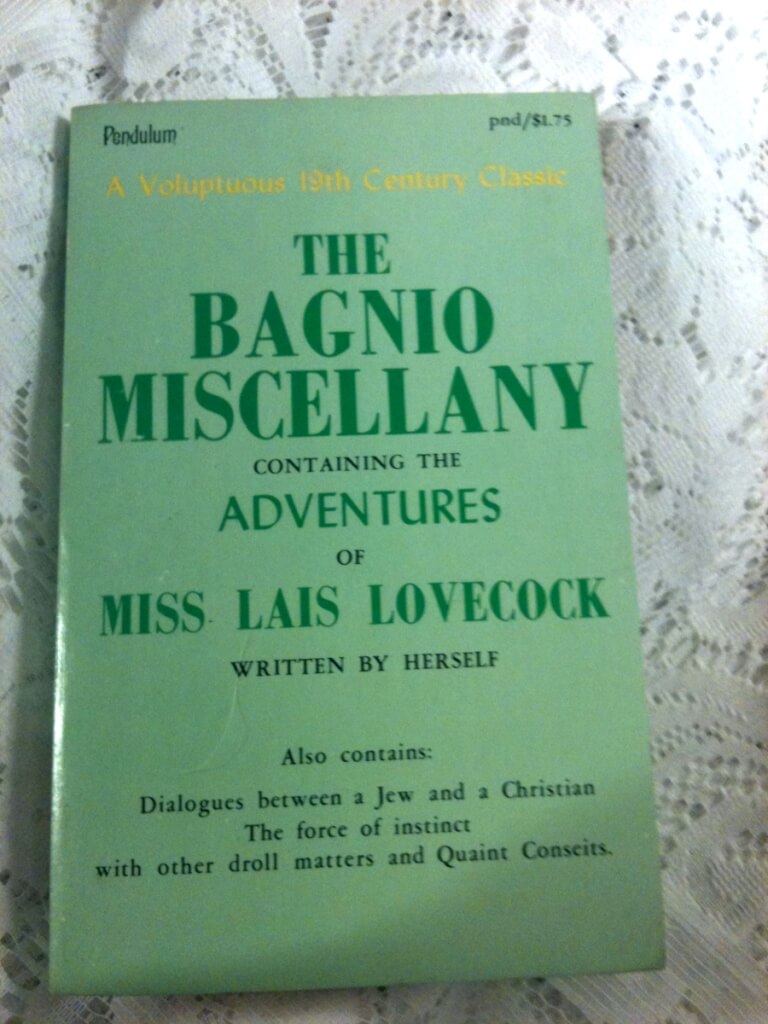-
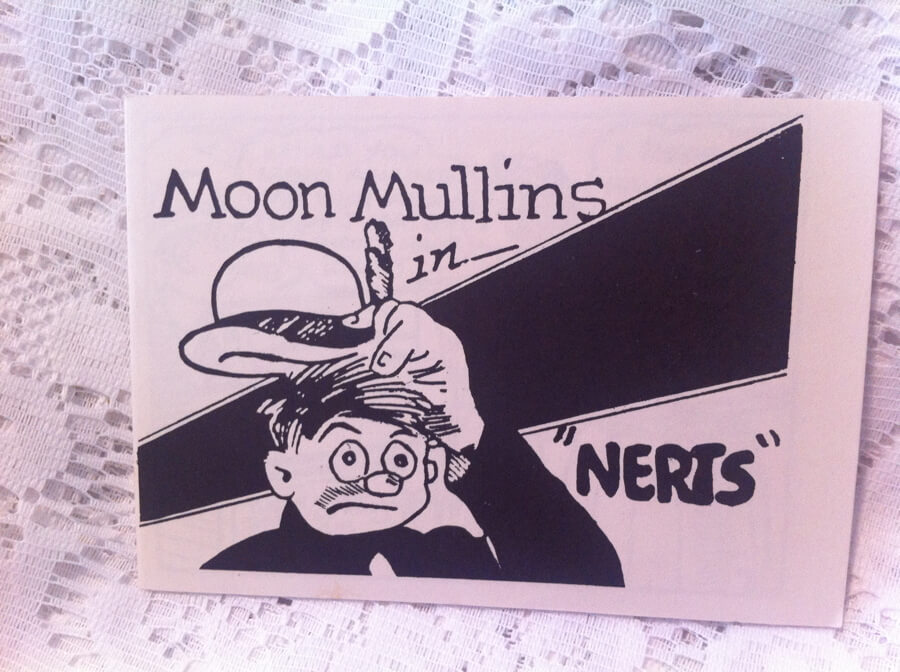
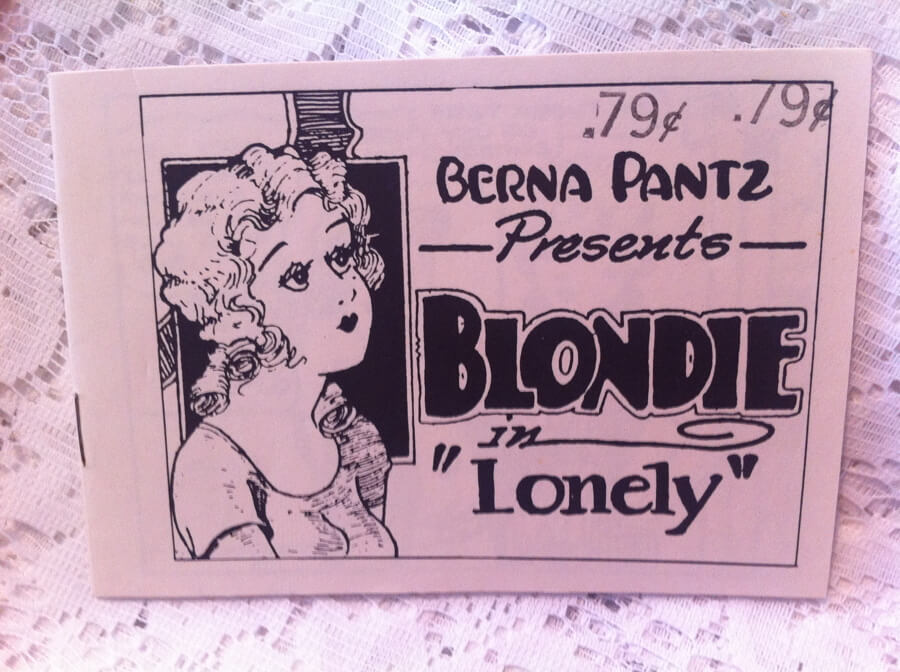 Berna Pantz Presents Blondie in "Lonely" / Moon Mullins in "Nerts", (n.p., n.d.) 5" x 3.5", 8pp. double pamphlet, stapled Tijuana bibles (also known as eight-pagers, bluesies, gray-backs, Jiggs-and-Maggie books, jo-jo books, Tillie-and-Mac books, and two-by-fours) were little pornographic comic books produced in the United States from the 1920s to the early 1960s. This book is two books in one, featuring reprints of the originals printed on both sides of the paper. Flip the book over and it's a different book.
Berna Pantz Presents Blondie in "Lonely" / Moon Mullins in "Nerts", (n.p., n.d.) 5" x 3.5", 8pp. double pamphlet, stapled Tijuana bibles (also known as eight-pagers, bluesies, gray-backs, Jiggs-and-Maggie books, jo-jo books, Tillie-and-Mac books, and two-by-fours) were little pornographic comic books produced in the United States from the 1920s to the early 1960s. This book is two books in one, featuring reprints of the originals printed on both sides of the paper. Flip the book over and it's a different book. -
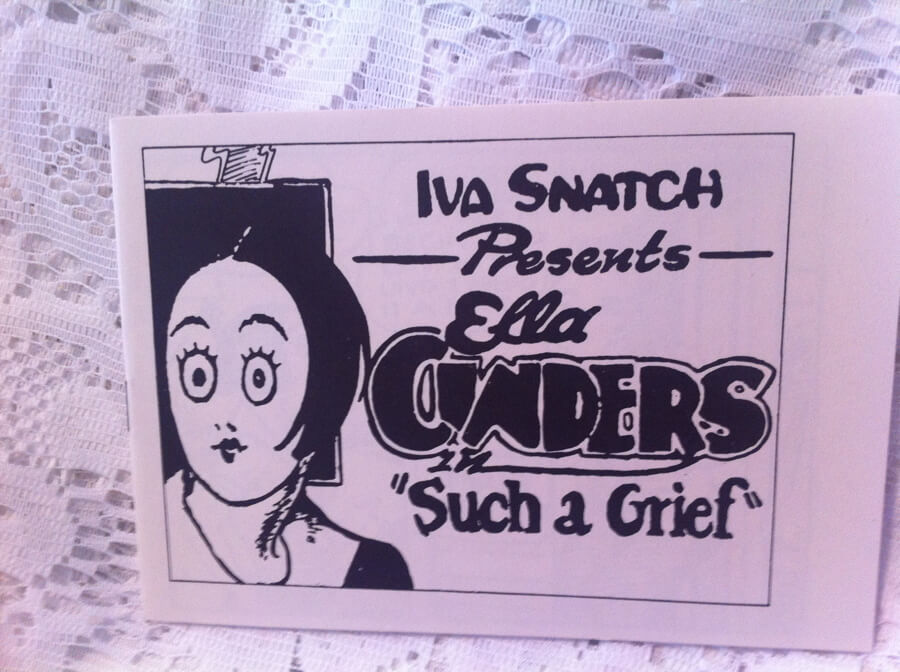
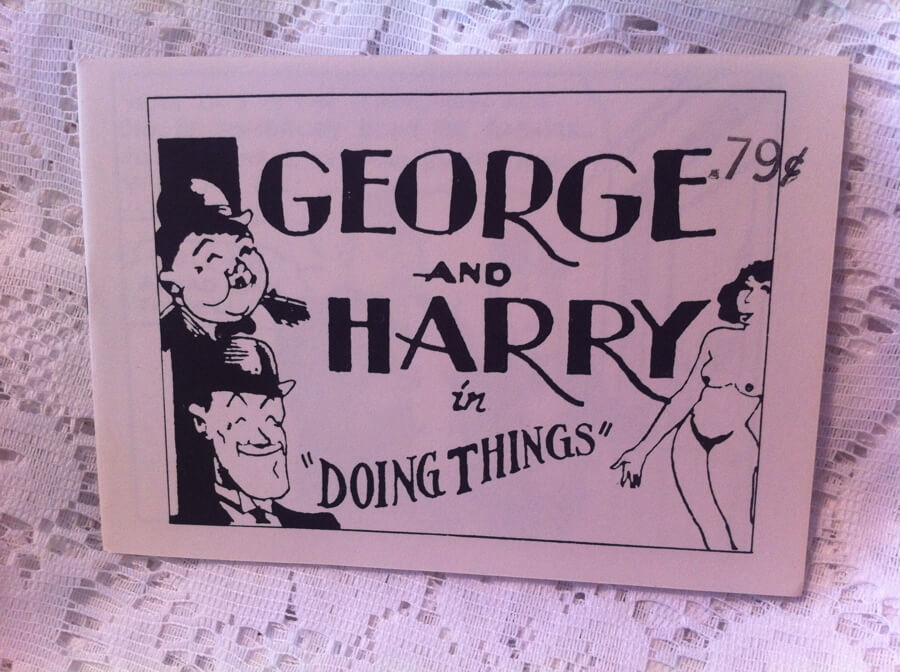 George and Harry in "Doing Things" / Iva Snatch Presents Ella Cinders in "Such a Grief", (n.p., n.d.) 5" x 3.5", 8pp. double pamphlet, stapled Tijuana bibles (also known as eight-pagers, bluesies, gray-backs, Jiggs-and-Maggie books, jo-jo books, Tillie-and-Mac books, and two-by-fours) were little pornographic comic books produced in the United States from the 1920s to the early 1960s. This book is two books in one, featuring reprints of the originals printed on both sides of the paper. Flip the book over and it's a different book.
George and Harry in "Doing Things" / Iva Snatch Presents Ella Cinders in "Such a Grief", (n.p., n.d.) 5" x 3.5", 8pp. double pamphlet, stapled Tijuana bibles (also known as eight-pagers, bluesies, gray-backs, Jiggs-and-Maggie books, jo-jo books, Tillie-and-Mac books, and two-by-fours) were little pornographic comic books produced in the United States from the 1920s to the early 1960s. This book is two books in one, featuring reprints of the originals printed on both sides of the paper. Flip the book over and it's a different book. -

 J. Wellington, Wimpy in "Back to his First Love" / That's My Pop, (n.p., n.d.) 5" x 3.5", 8pp. double pamphlet, stapled Tijuana bibles (also known as eight-pagers, bluesies, gray-backs, Jiggs-and-Maggie books, jo-jo books, Tillie-and-Mac books, and two-by-fours) were little pornographic comic books produced in the United States from the 1920s to the early 1960s. This book is two books in one, featuring reprints of the originals printed on both sides of the paper. Flip the book over and it's a different book.
J. Wellington, Wimpy in "Back to his First Love" / That's My Pop, (n.p., n.d.) 5" x 3.5", 8pp. double pamphlet, stapled Tijuana bibles (also known as eight-pagers, bluesies, gray-backs, Jiggs-and-Maggie books, jo-jo books, Tillie-and-Mac books, and two-by-fours) were little pornographic comic books produced in the United States from the 1920s to the early 1960s. This book is two books in one, featuring reprints of the originals printed on both sides of the paper. Flip the book over and it's a different book. -
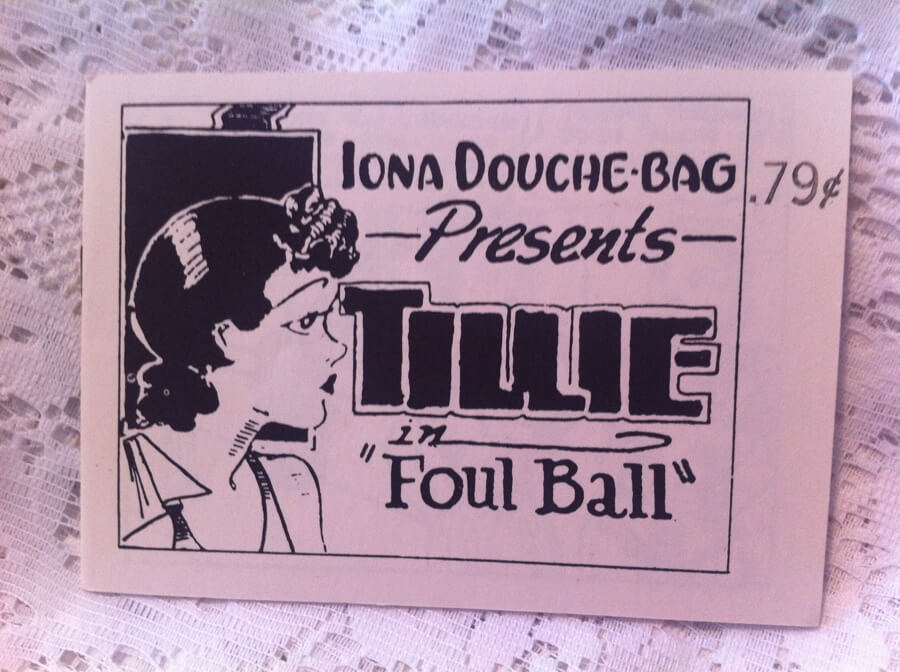
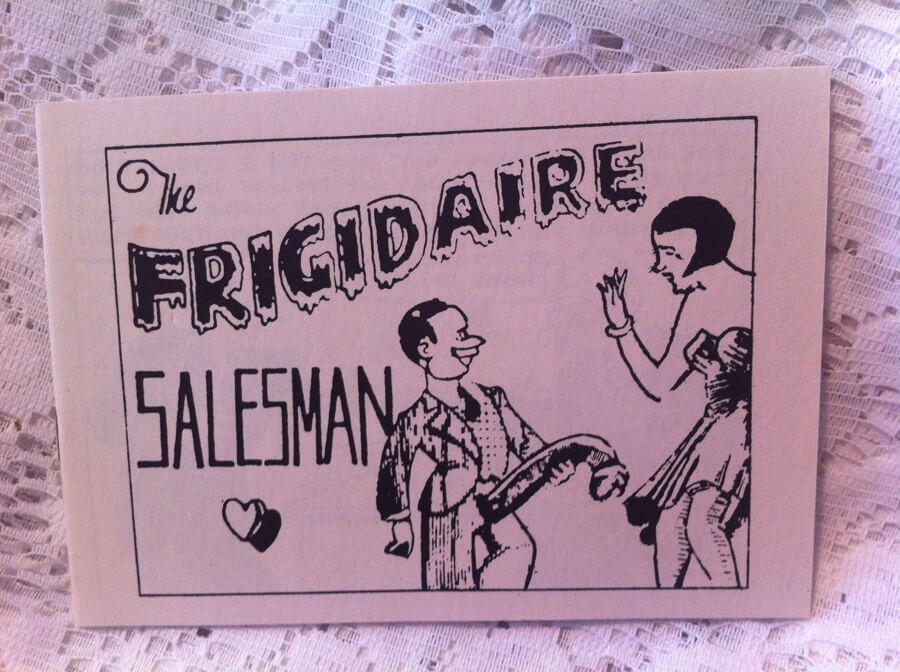 The Frigidaire Salesman / Iona Douche-Bag Presents Tillie in "Foul Ball", (n.p., n.d.) 5" x 3.5", 8pp. double pamphlet, stapled Tijuana bibles (also known as eight-pagers, bluesies, gray-backs, Jiggs-and-Maggie books, jo-jo books, Tillie-and-Mac books, and two-by-fours) were little pornographic comic books produced in the United States from the 1920s to the early 1960s. This book is two books in one, featuring reprints of the originals printed on both sides of the paper. Flip the book over and it's a different book.
The Frigidaire Salesman / Iona Douche-Bag Presents Tillie in "Foul Ball", (n.p., n.d.) 5" x 3.5", 8pp. double pamphlet, stapled Tijuana bibles (also known as eight-pagers, bluesies, gray-backs, Jiggs-and-Maggie books, jo-jo books, Tillie-and-Mac books, and two-by-fours) were little pornographic comic books produced in the United States from the 1920s to the early 1960s. This book is two books in one, featuring reprints of the originals printed on both sides of the paper. Flip the book over and it's a different book. -
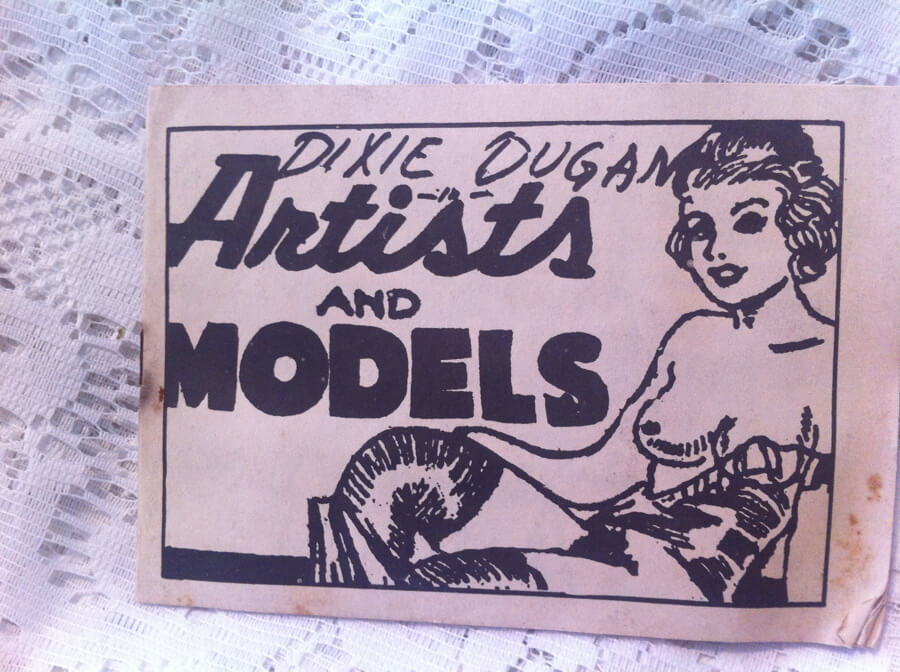
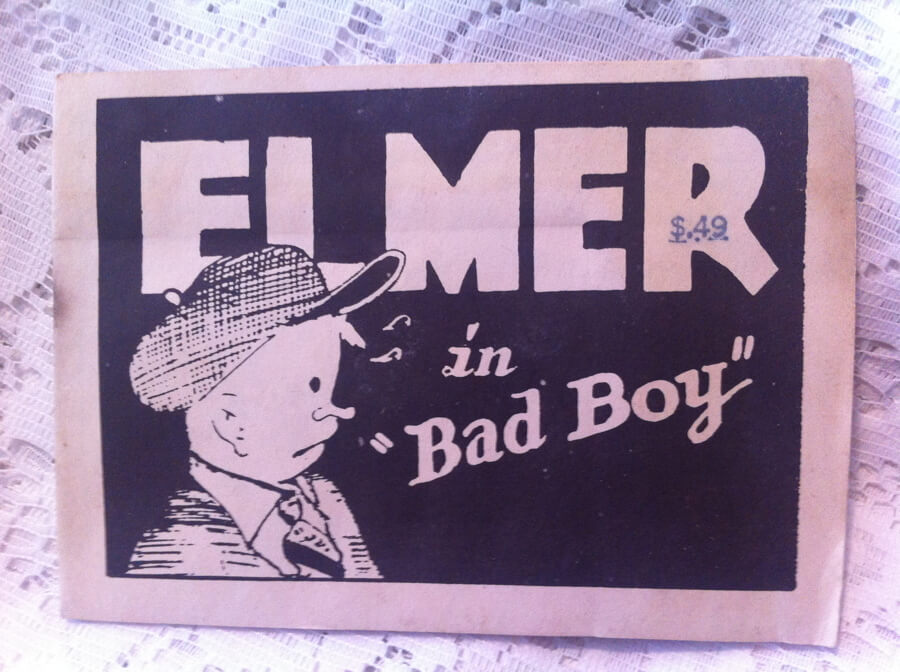 Elmer in "Bad Boy" / Dixie Dugan in Artists and Models, (n.p., n.d.) 5" x 3.5", 8pp. double pamphlet, stapled Tijuana bibles (also known as eight-pagers, bluesies, gray-backs, Jiggs-and-Maggie books, jo-jo books, Tillie-and-Mac books, and two-by-fours) were little pornographic comic books produced in the United States from the 1920s to the early 1960s. This book is two books in one, featuring reprints of the originals printed on both sides of the paper. Flip the book over and it's a different book.
Elmer in "Bad Boy" / Dixie Dugan in Artists and Models, (n.p., n.d.) 5" x 3.5", 8pp. double pamphlet, stapled Tijuana bibles (also known as eight-pagers, bluesies, gray-backs, Jiggs-and-Maggie books, jo-jo books, Tillie-and-Mac books, and two-by-fours) were little pornographic comic books produced in the United States from the 1920s to the early 1960s. This book is two books in one, featuring reprints of the originals printed on both sides of the paper. Flip the book over and it's a different book. -
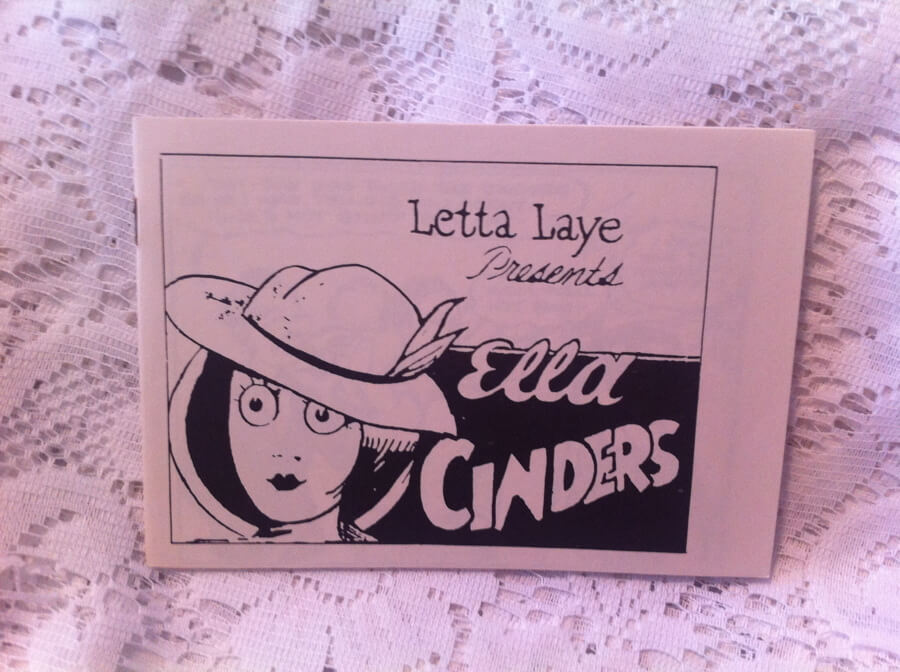
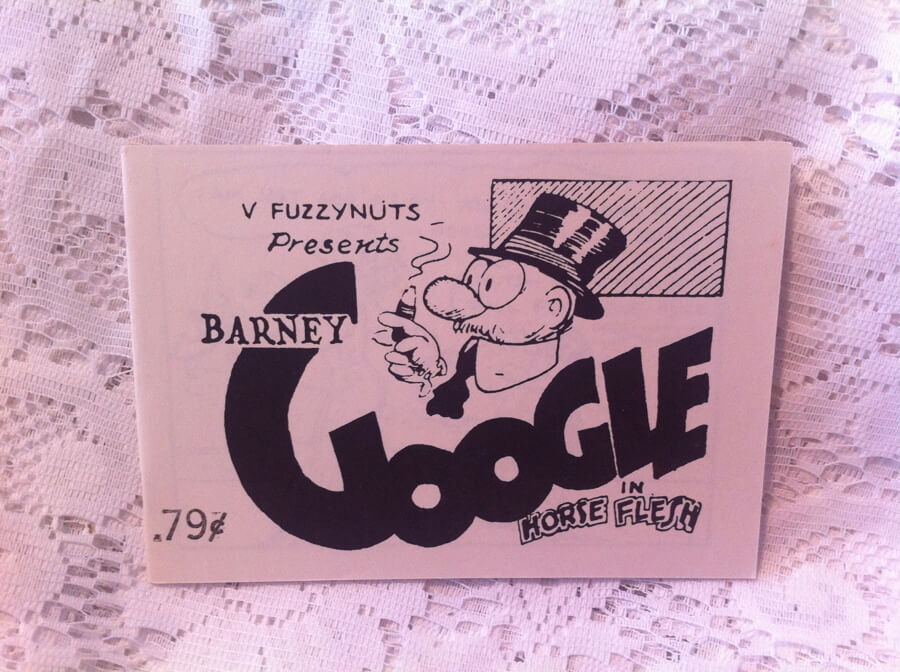 V Fuzzynuts Presents Barney Google in Horse Flesh / Letta Laye Presents Ella Cinders, (n.p., n.d.) 5" x 3.5", 8pp. double pamphlet, stapled Tijuana bibles (also known as eight-pagers, bluesies, gray-backs, Jiggs-and-Maggie books, jo-jo books, Tillie-and-Mac books, and two-by-fours) were little pornographic comic books produced in the United States from the 1920s to the early 1960s. This book is two books in one, featuring reprints of the originals printed on both sides of the paper. Flip the book over and it's a different book.
V Fuzzynuts Presents Barney Google in Horse Flesh / Letta Laye Presents Ella Cinders, (n.p., n.d.) 5" x 3.5", 8pp. double pamphlet, stapled Tijuana bibles (also known as eight-pagers, bluesies, gray-backs, Jiggs-and-Maggie books, jo-jo books, Tillie-and-Mac books, and two-by-fours) were little pornographic comic books produced in the United States from the 1920s to the early 1960s. This book is two books in one, featuring reprints of the originals printed on both sides of the paper. Flip the book over and it's a different book. -
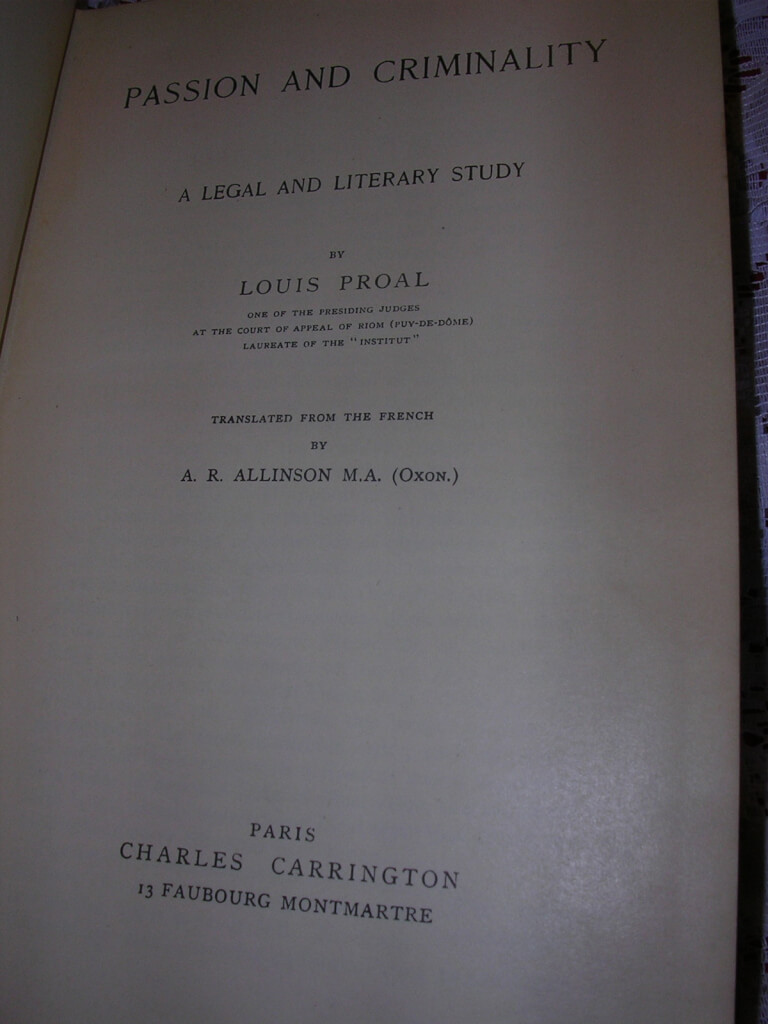
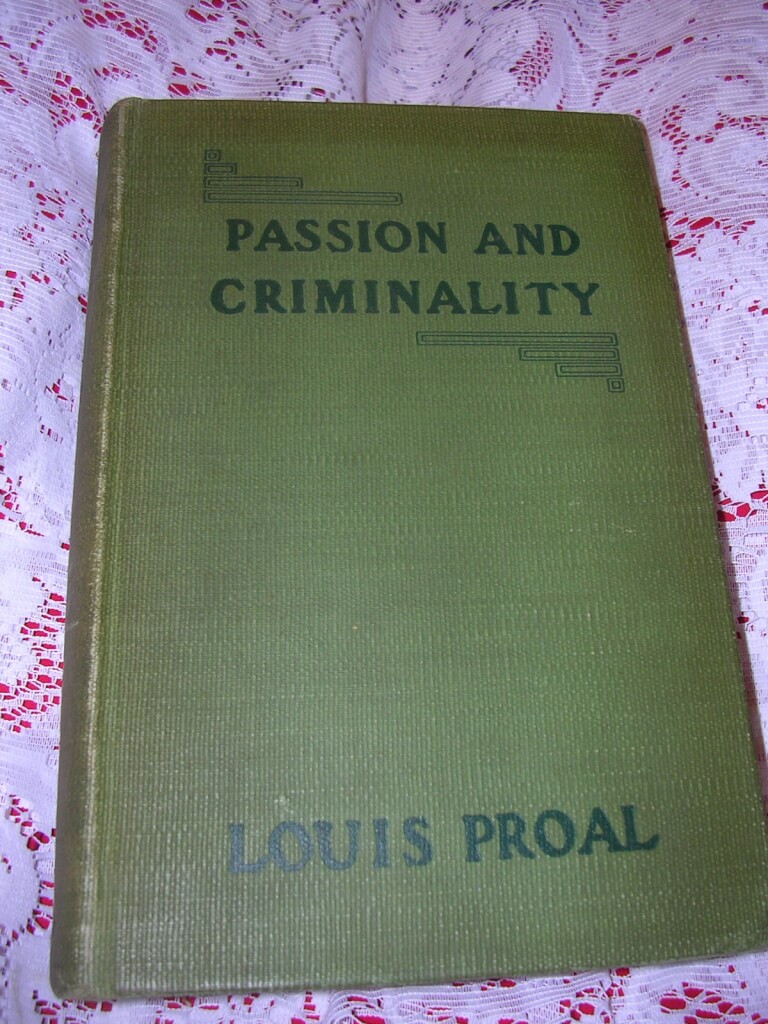 Passion and Criminality | a legal and literary study, Louis Proal, trans. "A. R. Allinson M.A. (Oxon.)" (stated "Charles Carrington, Paris, nd [c. 1930 pirated edition of the 1901 Charles Carrington edition]) 8.5" X 5.75", xxiv 679pp. Hardbound no DJ. Green boards. Fair condition, front boards loose but intact, otherwise binding is good some sunning to boards. Proal was a French judge at the Court of Appeals of Riom. This book records the history of various crimes of passion and their sociological and legal implications. Covered here are suicide, love and hate combined, seduction and desertion, jealousy, adultery, crimes of passion resulting from reading books of passion.. etc. There seems to be a great deal of writing on melancholy and suicide. There is a Foreword by the translator.
Passion and Criminality | a legal and literary study, Louis Proal, trans. "A. R. Allinson M.A. (Oxon.)" (stated "Charles Carrington, Paris, nd [c. 1930 pirated edition of the 1901 Charles Carrington edition]) 8.5" X 5.75", xxiv 679pp. Hardbound no DJ. Green boards. Fair condition, front boards loose but intact, otherwise binding is good some sunning to boards. Proal was a French judge at the Court of Appeals of Riom. This book records the history of various crimes of passion and their sociological and legal implications. Covered here are suicide, love and hate combined, seduction and desertion, jealousy, adultery, crimes of passion resulting from reading books of passion.. etc. There seems to be a great deal of writing on melancholy and suicide. There is a Foreword by the translator. -
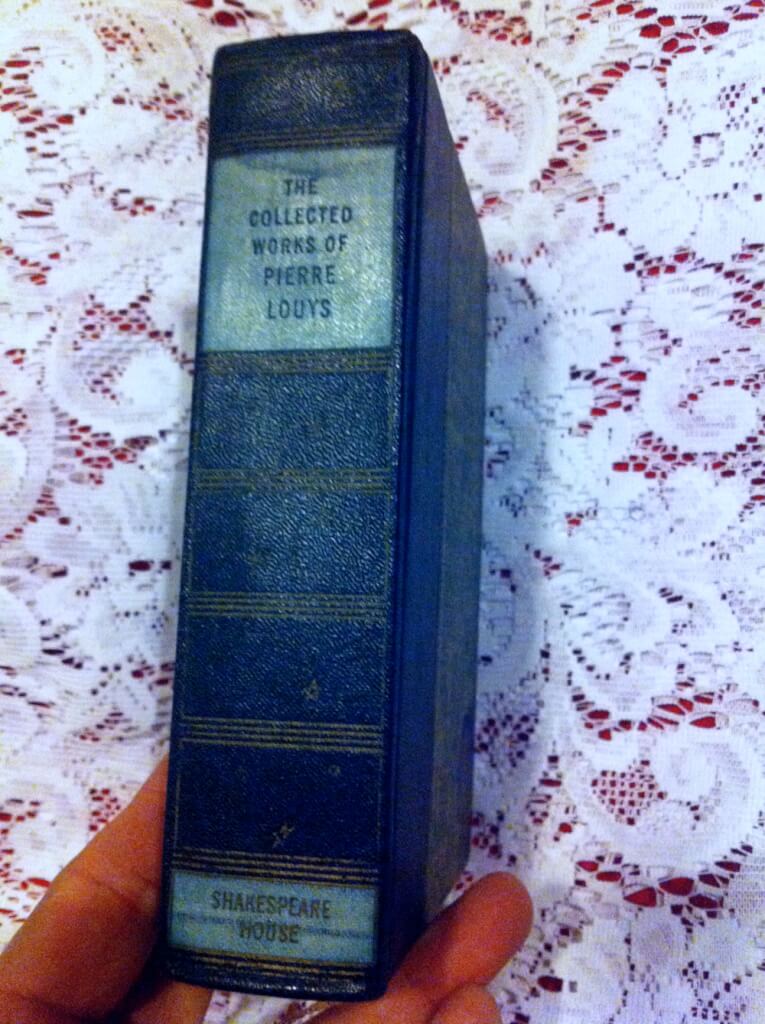
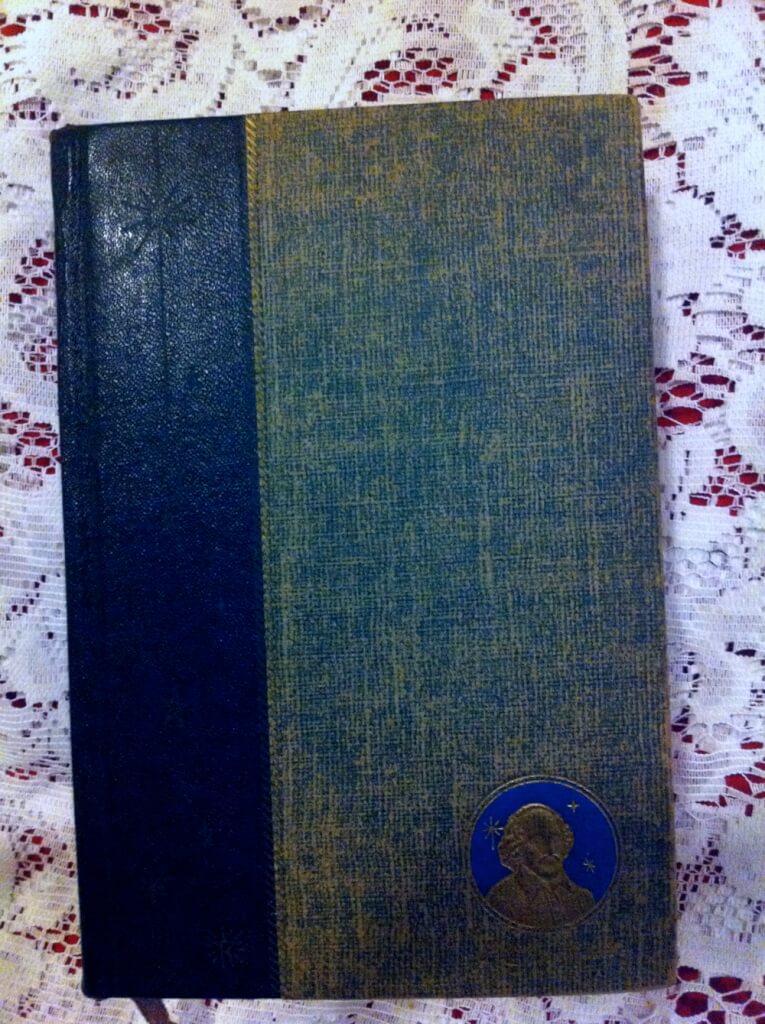 Collected Works of Pierre Louys, Pierre Louys (Shakespeare House, New York, 1951) 6.75" X 4.5", 628pp., hardbound in blue-grey buckram boards with simulated leather spine, gilt decorations (portrait of Shakespear) on cover. Fine condition, ribbon intact. Pierre Louys (1870 - 1925) was a French poet and writer, most renowned for lesbian and classical themes in some of his writings. He is known as a writer who "expressed pagan sensuality with stylistic perfection." This is a collection which contains Aphrodite, The Songs of Bilitis, The Adventures of King Pausole, and 9 of his short stories.
Collected Works of Pierre Louys, Pierre Louys (Shakespeare House, New York, 1951) 6.75" X 4.5", 628pp., hardbound in blue-grey buckram boards with simulated leather spine, gilt decorations (portrait of Shakespear) on cover. Fine condition, ribbon intact. Pierre Louys (1870 - 1925) was a French poet and writer, most renowned for lesbian and classical themes in some of his writings. He is known as a writer who "expressed pagan sensuality with stylistic perfection." This is a collection which contains Aphrodite, The Songs of Bilitis, The Adventures of King Pausole, and 9 of his short stories. -
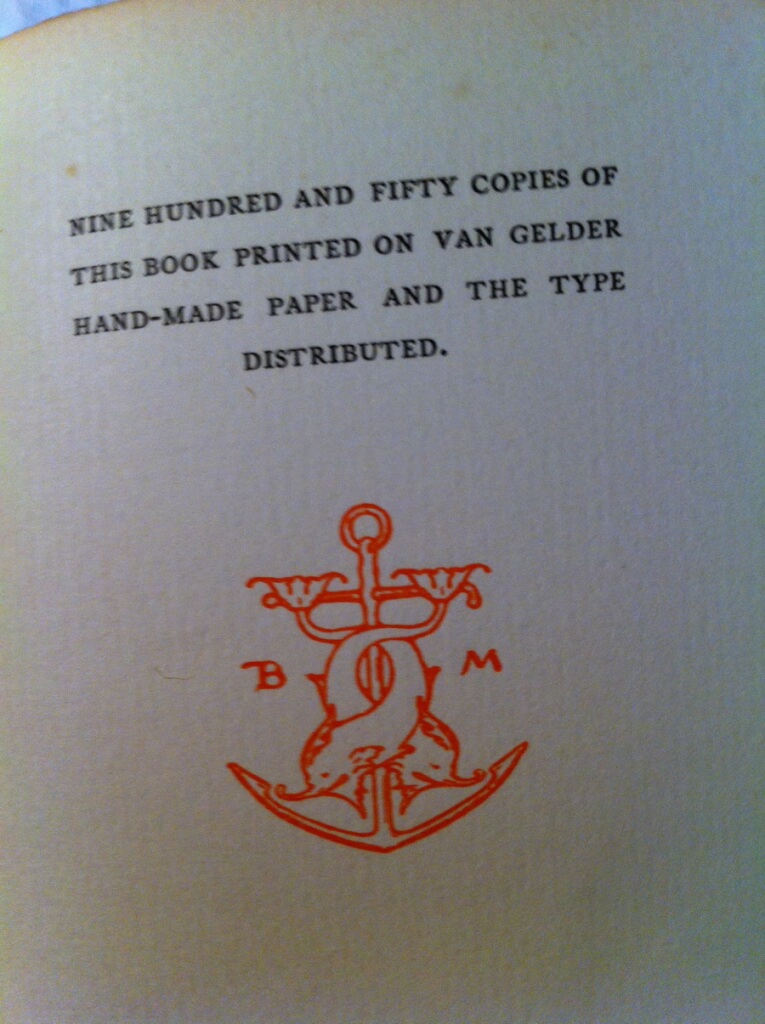
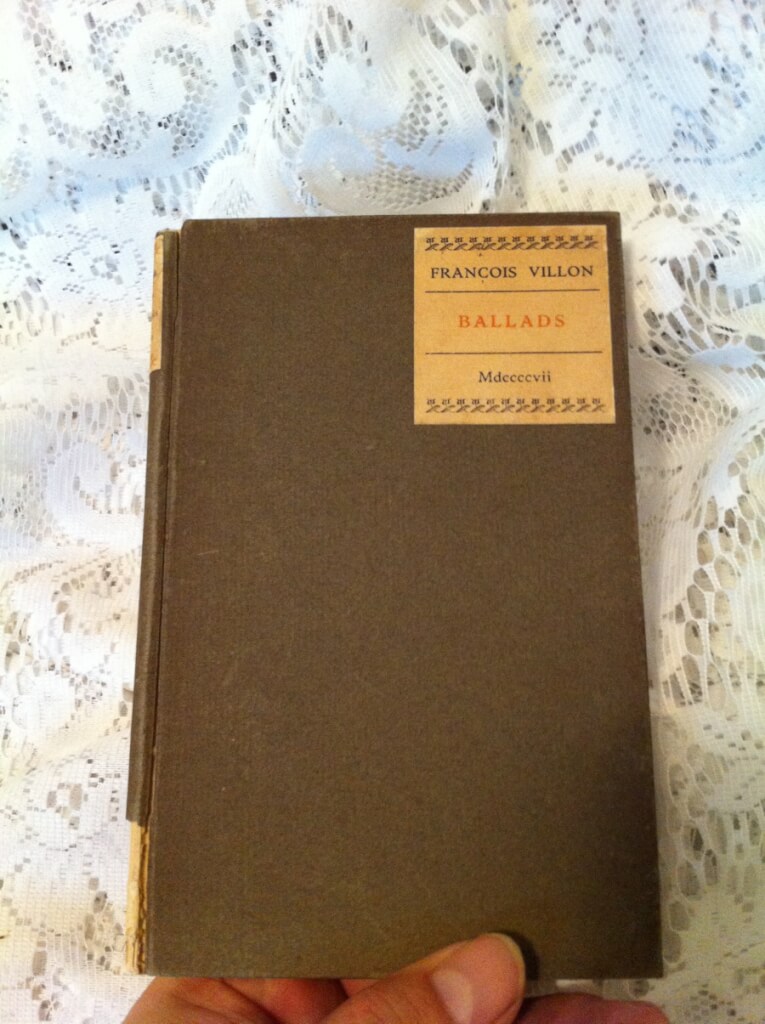 Ballands Done Into English from the French of Francois Villon, Francois Villon (Thomas B. Mosher, 1907) 7" X 4.5", 43pp, hardbound, grey boards with paper labels on cover and spine. Fair condition for age, spine loose on one side but holding, hinges good, fore and bottom edges deckled, owner's signatures on front pastedown François Villon (c. 1431_1464) was a French poet. Most of what is known about Villon has been gathered from legal records and gleaned from his own writings. He was a thief, killer, barroom brawler, and vagabond. He is perhaps best known for his Testaments and his Ballades. He was the most famous realist poet of the Middle Ages.
Ballands Done Into English from the French of Francois Villon, Francois Villon (Thomas B. Mosher, 1907) 7" X 4.5", 43pp, hardbound, grey boards with paper labels on cover and spine. Fair condition for age, spine loose on one side but holding, hinges good, fore and bottom edges deckled, owner's signatures on front pastedown François Villon (c. 1431_1464) was a French poet. Most of what is known about Villon has been gathered from legal records and gleaned from his own writings. He was a thief, killer, barroom brawler, and vagabond. He is perhaps best known for his Testaments and his Ballades. He was the most famous realist poet of the Middle Ages. -

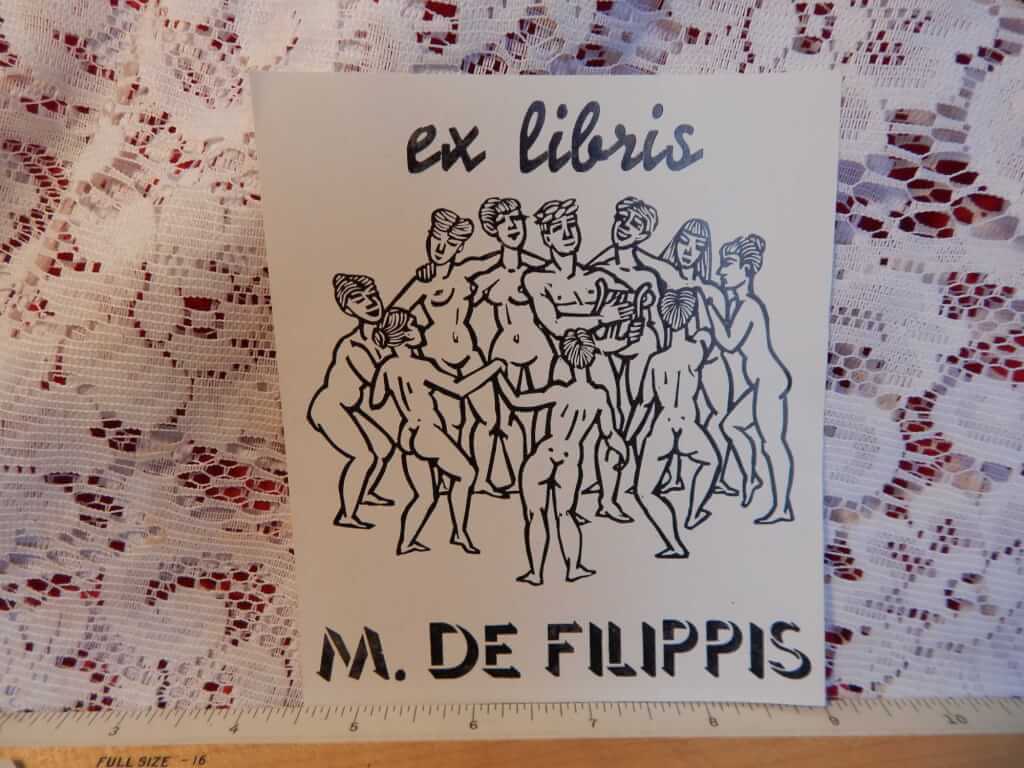 Ex Libris M. De Filippis by Constante Constantini 4.5 x 5.25", purchased from a collection in Italy, "Constantini, Italia, x/3, 1987" stamped on back Naked man playing a harp while naked dancers encircle him. One of the most important (and largest) collections of ex libris in the world belongs to Mario De Filippis, the owner of Buca di San Francesco restaurant in Arezzo Italy. He has over 130,000 ex libris in his collection, approximately 13,000 are personal ex libris plates he's commissioned from artists all over the world using a multitude of printing techniques. His website describes Mario as "a passionate lover of small graphics".
Ex Libris M. De Filippis by Constante Constantini 4.5 x 5.25", purchased from a collection in Italy, "Constantini, Italia, x/3, 1987" stamped on back Naked man playing a harp while naked dancers encircle him. One of the most important (and largest) collections of ex libris in the world belongs to Mario De Filippis, the owner of Buca di San Francesco restaurant in Arezzo Italy. He has over 130,000 ex libris in his collection, approximately 13,000 are personal ex libris plates he's commissioned from artists all over the world using a multitude of printing techniques. His website describes Mario as "a passionate lover of small graphics". -
Out of stock
 Ex Libris Giuseppe Cauti, by Franco Rognoni purchased from a collection in Italy. Naked woman being admired by men in top hats. Franco Rognoni (1913-1999) was an Italian artist and illustrator
Ex Libris Giuseppe Cauti, by Franco Rognoni purchased from a collection in Italy. Naked woman being admired by men in top hats. Franco Rognoni (1913-1999) was an Italian artist and illustrator -
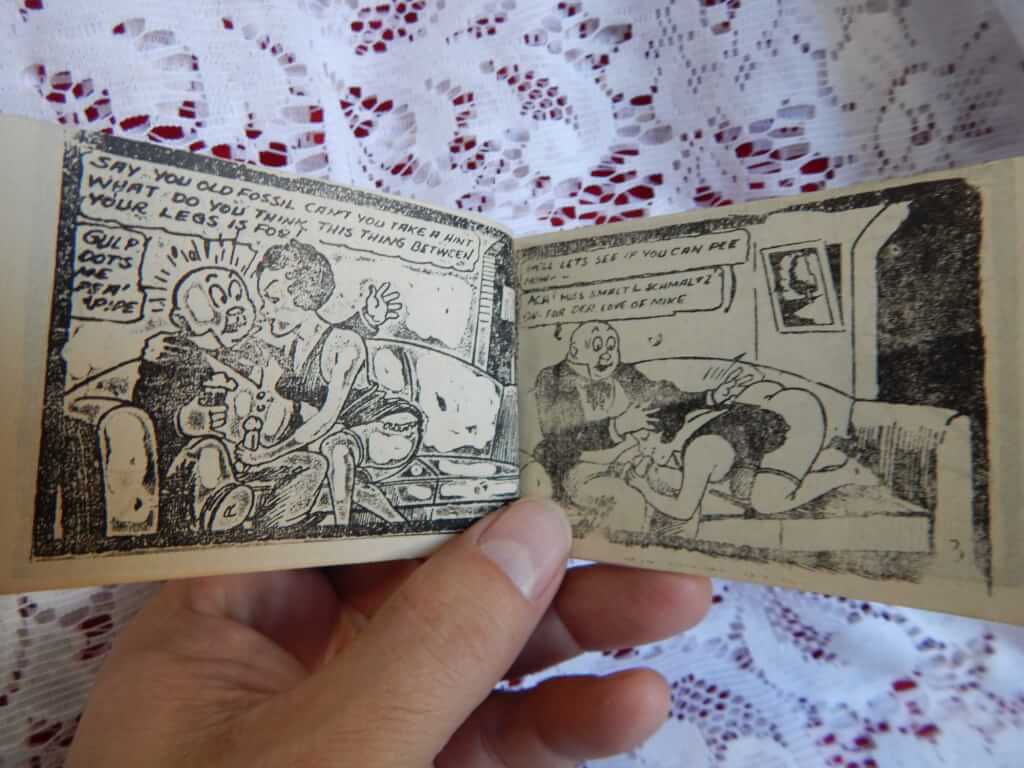
 Dingle Hoofer and his Dog Aolph, (n.p. n.d.) 4.5" x 3", 8pp. pamphlet, stapled, cover detatched Tijuana bibles (also known as eight-pagers, bluesies, gray-backs, Jiggs-and-Maggie books, jo-jo books, Tillie-and-Mac books, and two-by-fours) were little pornographic comic books produced in the United States from the 1920s to the early 1960s.
Dingle Hoofer and his Dog Aolph, (n.p. n.d.) 4.5" x 3", 8pp. pamphlet, stapled, cover detatched Tijuana bibles (also known as eight-pagers, bluesies, gray-backs, Jiggs-and-Maggie books, jo-jo books, Tillie-and-Mac books, and two-by-fours) were little pornographic comic books produced in the United States from the 1920s to the early 1960s. -
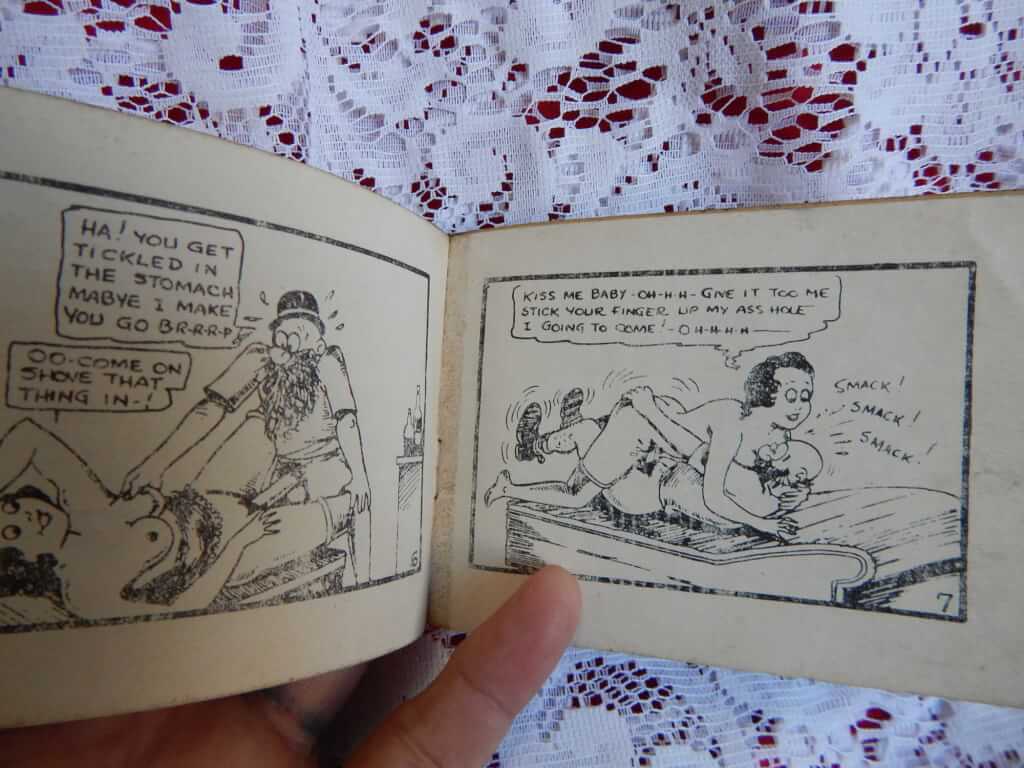
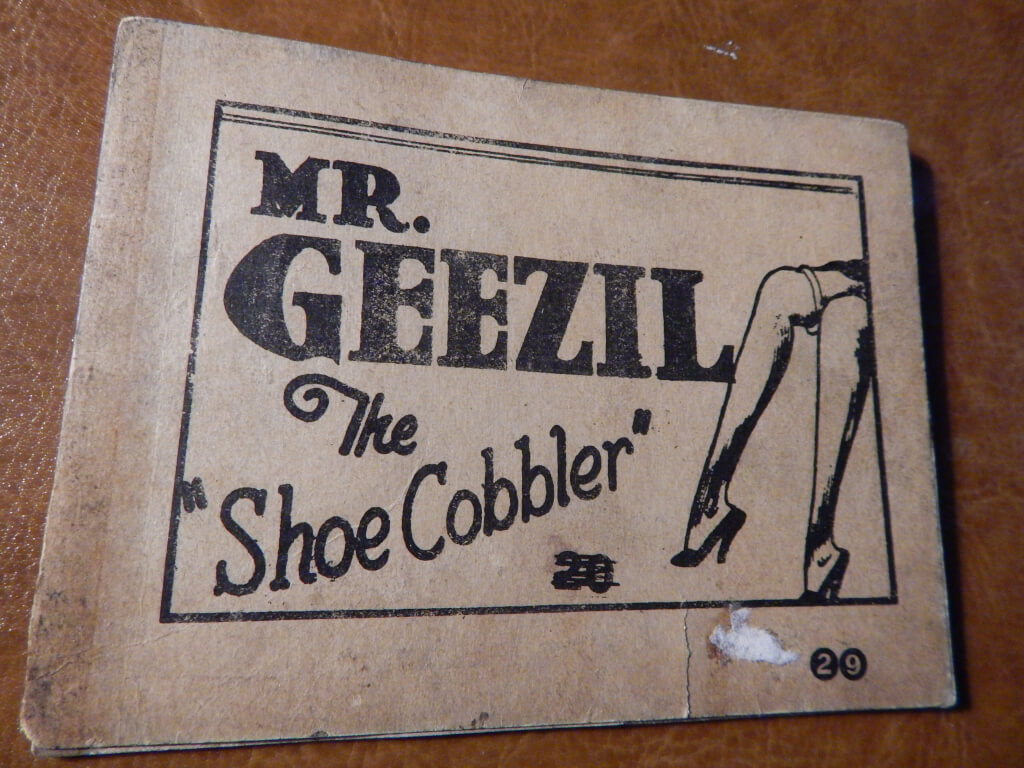 Mr. Geezil, the "Shoe Cobbler", (np. nd.) 4.5" x 3", 8pp., pamphlet, stapled and taped Tijuana bibles (also known as eight-pagers, bluesies, gray-backs, Jiggs-and-Maggie books, jo-jo books, Tillie-and-Mac books, and two-by-fours) were little pornographic comic books produced in the United States from the 1920s to the early 1960s.
Mr. Geezil, the "Shoe Cobbler", (np. nd.) 4.5" x 3", 8pp., pamphlet, stapled and taped Tijuana bibles (also known as eight-pagers, bluesies, gray-backs, Jiggs-and-Maggie books, jo-jo books, Tillie-and-Mac books, and two-by-fours) were little pornographic comic books produced in the United States from the 1920s to the early 1960s. -
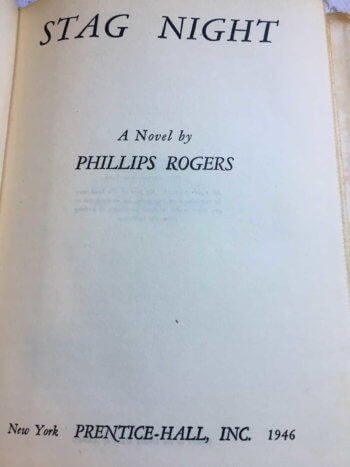
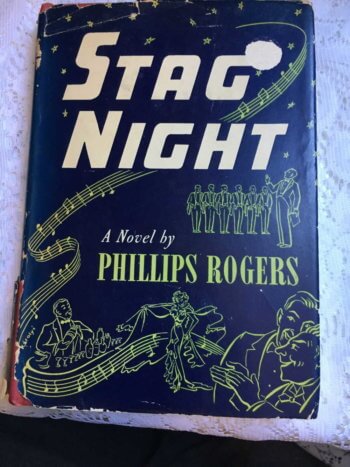 Stag Night, by Phillips Rogers (Prentice-Hall, Inc, New York, 1946) 6" x 8.5", 230pp, hardcover with DJ, red boards with black titles on spine, DJ in fair shape, yellowing throughout, binding good [from Dust Jacket] "Stag Night is a revealing novel about an affair that the men reminisce over for a year and their wives wonder about--the annual Gentleman's Dinner at a country club." "The entire action of Stag Night takes place in one evening at a country club. It begins with the arrival of a tightly girdled whisky-loving Mrs. Riordan ("Fatima") who has for many years given her Dance of the Seven Veils at the Gentleman's Dinner. It ends with tactful and wise Heinz, the head waiter, bidding the police goodnight. In between is depicted the frenzied activity of the chef and the dour bartender, the ribald behavior of some of the stags, the bewilderment of an innocent young refugee dancer, and the mounting excitement as the moment nears for the showing of lewd movies. Tragedy in a grotesque form stalks the evening and at the climax the diners receive the surprise of their lives — and we don't mean the cops in the hall."
Stag Night, by Phillips Rogers (Prentice-Hall, Inc, New York, 1946) 6" x 8.5", 230pp, hardcover with DJ, red boards with black titles on spine, DJ in fair shape, yellowing throughout, binding good [from Dust Jacket] "Stag Night is a revealing novel about an affair that the men reminisce over for a year and their wives wonder about--the annual Gentleman's Dinner at a country club." "The entire action of Stag Night takes place in one evening at a country club. It begins with the arrival of a tightly girdled whisky-loving Mrs. Riordan ("Fatima") who has for many years given her Dance of the Seven Veils at the Gentleman's Dinner. It ends with tactful and wise Heinz, the head waiter, bidding the police goodnight. In between is depicted the frenzied activity of the chef and the dour bartender, the ribald behavior of some of the stags, the bewilderment of an innocent young refugee dancer, and the mounting excitement as the moment nears for the showing of lewd movies. Tragedy in a grotesque form stalks the evening and at the climax the diners receive the surprise of their lives — and we don't mean the cops in the hall." -
Out of stock
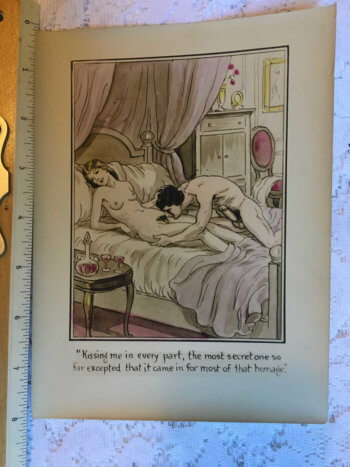
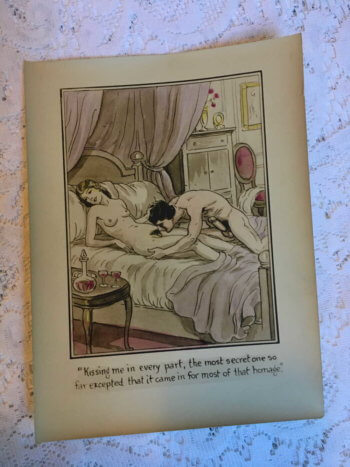 Fanny Hill print "Kissing me in every part, the most secret one so far excepted that it came in for most of that homage." 6 x 8", hand colored This print came from someone's private collection. The rest of the prints I have from this estate are also from various editions of Fanny Hill by John Cleland. I'm unsure of the edition but this seems to be a print from the 1920-30s and hand colored.
Fanny Hill print "Kissing me in every part, the most secret one so far excepted that it came in for most of that homage." 6 x 8", hand colored This print came from someone's private collection. The rest of the prints I have from this estate are also from various editions of Fanny Hill by John Cleland. I'm unsure of the edition but this seems to be a print from the 1920-30s and hand colored. -
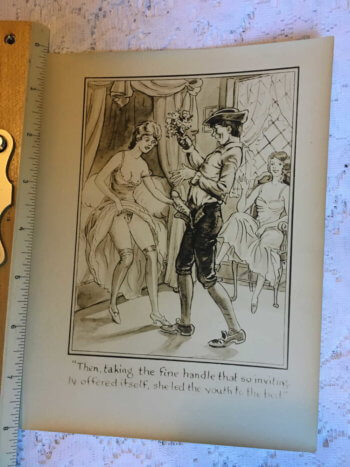
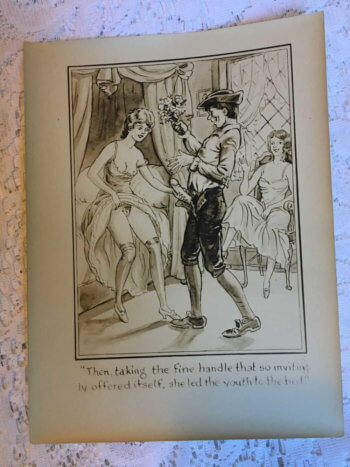 Fanny Hill print "Then, taking the fine handle that so invitingly offered itself, she led the youth to the bed." 6 x 8" This print came from someone's private collection. The rest of the prints I have from this estate are also from various editions of Fanny Hill by John Cleland. I'm unsure of the edition but this seems to be a print from the 1920-30s.
Fanny Hill print "Then, taking the fine handle that so invitingly offered itself, she led the youth to the bed." 6 x 8" This print came from someone's private collection. The rest of the prints I have from this estate are also from various editions of Fanny Hill by John Cleland. I'm unsure of the edition but this seems to be a print from the 1920-30s. -
Out of stock
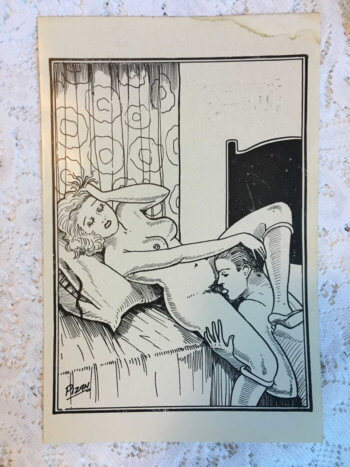
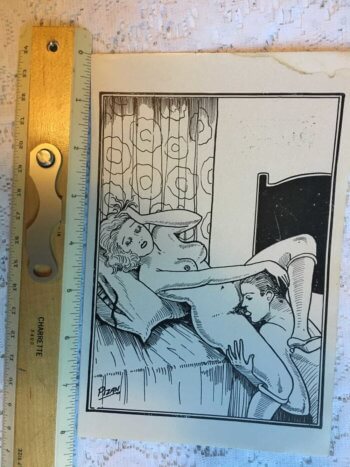 Fanny Hill print 5.5 x 8.25" This print came from someone's private collection. The rest of the prints I have from this estate are also from various editions of Fanny Hill by John Cleland. Print is by "PIZAN" and is possibly from a 20-30s edition printed clandestinely in NY.
Fanny Hill print 5.5 x 8.25" This print came from someone's private collection. The rest of the prints I have from this estate are also from various editions of Fanny Hill by John Cleland. Print is by "PIZAN" and is possibly from a 20-30s edition printed clandestinely in NY. -
 Memoirs of Fanny Hill, John Cleland (Privately Printed, The Kamashastra Society, 1907 [likely pirated copy of the Paris Kamashastra edition, likely clandestinely printed in the US, c. 1920-30s]) 8.75" X 5.75", 287pp, hardbound no DJ, top edge dyed blue, fair condition, binding good, boards are loose but holding. Written while the author was in debtor's prison in London and first published in 1748, Fanny Hill is considered the first original English prose pornography, and the first pornography to use the form of the novel. One of the most prosecuted and banned books in history, it has become a synonym for obscenity. The title page is printed in black with green decorations. The contents mirror the Carrington versions of the book, reformatted and lacking the plates. The title is in black (not black and green as other Kamashastra editions) This leads me to believe that it is a likely US pirate of the Kamashastra (which is, itself a pirate of the Carrington version).
Memoirs of Fanny Hill, John Cleland (Privately Printed, The Kamashastra Society, 1907 [likely pirated copy of the Paris Kamashastra edition, likely clandestinely printed in the US, c. 1920-30s]) 8.75" X 5.75", 287pp, hardbound no DJ, top edge dyed blue, fair condition, binding good, boards are loose but holding. Written while the author was in debtor's prison in London and first published in 1748, Fanny Hill is considered the first original English prose pornography, and the first pornography to use the form of the novel. One of the most prosecuted and banned books in history, it has become a synonym for obscenity. The title page is printed in black with green decorations. The contents mirror the Carrington versions of the book, reformatted and lacking the plates. The title is in black (not black and green as other Kamashastra editions) This leads me to believe that it is a likely US pirate of the Kamashastra (which is, itself a pirate of the Carrington version). -
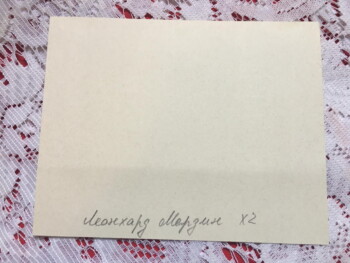
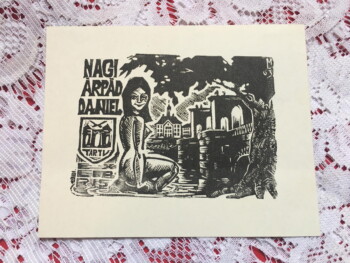 Ex Libris Nagi Arpad Daniel - Tartu 3.5 x 4.75", signed on the back, presumably by and for the Estonian artist, Arpad Daniel Nagy, Tartu is a city in Estonia nude woman sitting on rock in the water, behind her a bridge. Arpad Daniel Nagy was a creative visual artist. Arpad Daniel Nagy was born in 1922 and died in 1985. Arpad Daniel Nagy was largely inspired by the 1930s growing up. The period of the 1930s is characterised by the conflict between a number of political ideologies, including Marxist Socialism, Capitalist Democracy, and the Totalitarianism of both Communism and Fascism. Artistic output in the United States was heavily impacted at the time by the Great Depression, and a number of artists took to focusing on ideas of humility and the ordinary man. For the first time in US history, artists began to explore into political subjects and attempted to use their art to impact society. Themes such as poverty, lack of affordable housing, anti-lynching, anti-fascism, and workers' strikes were prevalent in many artists’ work. In the Soviet Union, Stalin’s government required urgent funds to implement the rapid industrialisation demanded by the first Five Year Plan. It initiated a secret plan to sell off treasures from the State Hermitage Museum in Leningrad (St. Petersburg), including a primary list of two hundred and fifty rare paintings by the Old Masters, many which found their way to the collection of Andrew Mellon via the New York based art dealing company, Knoedler. Surrealism continued to dominate in Europe, and had influence on an international scale. Artists such as Frida Kahlo and Diego Riviera in Mexico, worked to incorporate the ideas posed by Surrealism into their radical political ideologies, developing a new kind of magic realism. The decade took a ominous turn with the birth of National Socialism in Germany, followed by Adolf Hitler’s rise to power in 1933. By the end of the 1930s, the Second World War had begun; which preoccupied both artists and the global population.
Ex Libris Nagi Arpad Daniel - Tartu 3.5 x 4.75", signed on the back, presumably by and for the Estonian artist, Arpad Daniel Nagy, Tartu is a city in Estonia nude woman sitting on rock in the water, behind her a bridge. Arpad Daniel Nagy was a creative visual artist. Arpad Daniel Nagy was born in 1922 and died in 1985. Arpad Daniel Nagy was largely inspired by the 1930s growing up. The period of the 1930s is characterised by the conflict between a number of political ideologies, including Marxist Socialism, Capitalist Democracy, and the Totalitarianism of both Communism and Fascism. Artistic output in the United States was heavily impacted at the time by the Great Depression, and a number of artists took to focusing on ideas of humility and the ordinary man. For the first time in US history, artists began to explore into political subjects and attempted to use their art to impact society. Themes such as poverty, lack of affordable housing, anti-lynching, anti-fascism, and workers' strikes were prevalent in many artists’ work. In the Soviet Union, Stalin’s government required urgent funds to implement the rapid industrialisation demanded by the first Five Year Plan. It initiated a secret plan to sell off treasures from the State Hermitage Museum in Leningrad (St. Petersburg), including a primary list of two hundred and fifty rare paintings by the Old Masters, many which found their way to the collection of Andrew Mellon via the New York based art dealing company, Knoedler. Surrealism continued to dominate in Europe, and had influence on an international scale. Artists such as Frida Kahlo and Diego Riviera in Mexico, worked to incorporate the ideas posed by Surrealism into their radical political ideologies, developing a new kind of magic realism. The decade took a ominous turn with the birth of National Socialism in Germany, followed by Adolf Hitler’s rise to power in 1933. By the end of the 1930s, the Second World War had begun; which preoccupied both artists and the global population. -
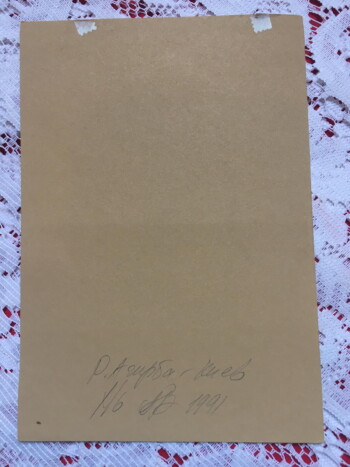
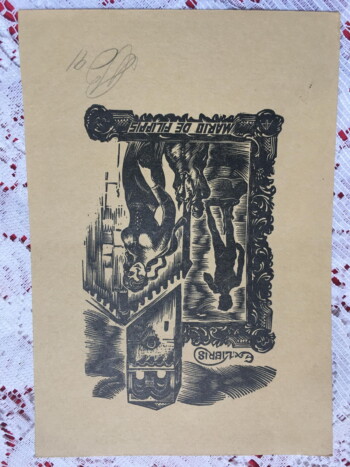 Ex Libris Mario de Filippis (signed) 5 x 4", signed on the front and back in pencil, presumably by artist Woman, man on horseback in front of Italian architecture and a silhouette of Michelangelo's David One of the most important (and largest) collections of ex libris in the world belongs to Mario De Filippis, the owner of Buca di San Francesco restaurant in Arezzo Italy. He has over 130,000 ex libris in his collection, approximately 13,000 are personal ex libris plates he's commissioned from artists all over the world using a multitude of printing techniques. His website describes Mario as "a passionate lover of small graphics".
Ex Libris Mario de Filippis (signed) 5 x 4", signed on the front and back in pencil, presumably by artist Woman, man on horseback in front of Italian architecture and a silhouette of Michelangelo's David One of the most important (and largest) collections of ex libris in the world belongs to Mario De Filippis, the owner of Buca di San Francesco restaurant in Arezzo Italy. He has over 130,000 ex libris in his collection, approximately 13,000 are personal ex libris plates he's commissioned from artists all over the world using a multitude of printing techniques. His website describes Mario as "a passionate lover of small graphics". -

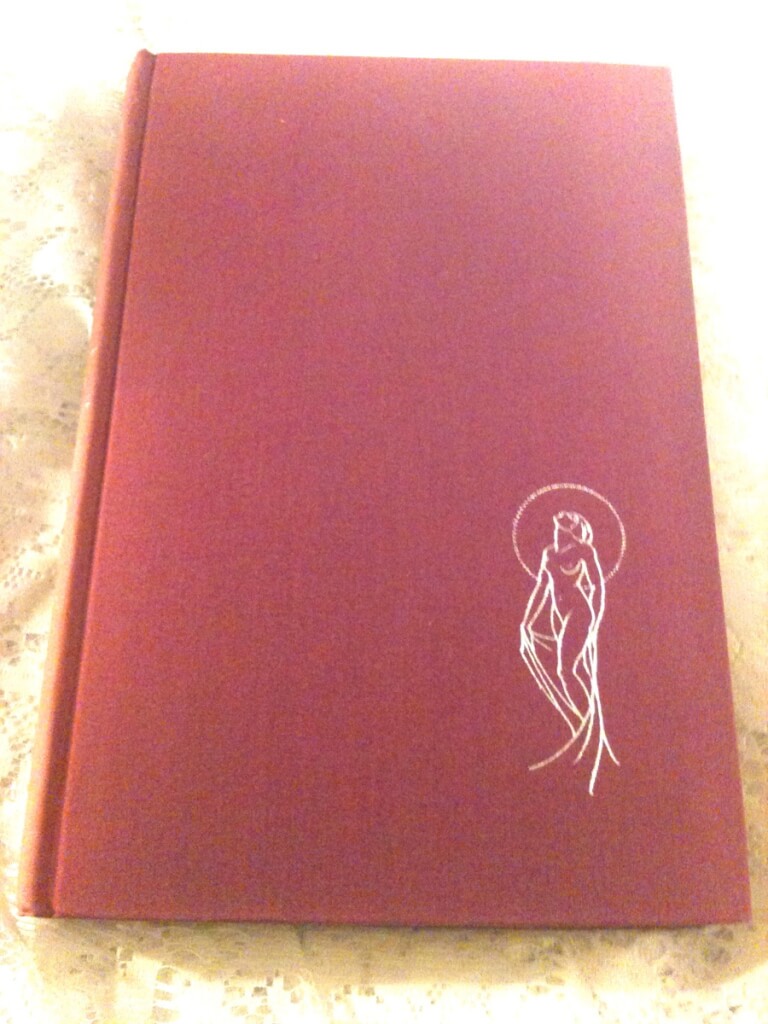 Amorous Fiammetta, Giovanni Boccaccio, introduction by Edward Hutton, trans. & illus. various unknown. (Rarity Press, New York, 1931 ) 9.5" X 6.5", 356pp, Hardcover no DJ, red cloth boards, botton and fore edges deckled. Good condition for age, a fading on spine, silver gilt lettering and decorations Originally titled "Elegia di Madonna Fiammetta" (The Elegy of Lady Fiammetta), this marvelous European romance was written by Giovanni Boccaccio somewhere between 1343 and 1344. It is a first-person confessional monologue narrated by a woman and is considered the first psychological novel in a modern language and a precursor of stream-of-consciousness fiction. Lady Fiammetta, recounts how, although a married woman, she falls in love with a handsome young foreigner named Panfilo and, becomes his lover. Panfilo subsequently abandons Fiammetta and returns to his native land, where his father is said to be dying. When he fails to keep his promise to return, Fiammetta, describes her longings, her anguish, and her despair. A host of contradictory sentiments drive her to desperation and to an unsuccessful suicide attempt. After a time, Fiammetta resumes her futile wait for Panfilo. She finally resolves to seek him out in his native land. Disguising her true intent from her husband, she secures his promise to help her in this undertaking. Addressing an exclusively female audience, Fiammetta warns them about the vicious ways of men. Her whole narrative adds up to an indictment of men as both readers and lovers. Fiammetta has been variously described as a pathetic victim of male cruelty; an irresponsible fool of a girl; a sophisticated, cunning, and wholly disingenuous female; and, finally, a genuinely modern woman. Whatever judgment we make of her, Fiammetta stands out among medieval women as an ardent and outspoken feminist. Sometime around 1330 Boccaccio fell in love and married his "Fiammetta" who most believe is Maria d'Aquino (?-1382), a royal bastard, an illegitimate daughter of Robert the Wise, King of Naples and Count of Provence. He wrote about her and their relationship in several of his literary works. She is traditionally identified as Fiammetta. According to him, Maria's mother was a Provençal noblewoman, Sibila Sabran, wife of Count Thomas IV of Aquino. She was born after Countess Sibila and King Robert committed adultery at his coronation festivities in 1310, but was given the family name of her mother's husband. Her putative father placed her in a convent. In 1345 she was an accomplice in the murder of King Andrew, the husband of her niece and Robert's successor, Queen Joanna I. For this Maria was sentenced to death and beheaded in 1382 on the orders of Queen Joanna I's successor, King Charles III.
Amorous Fiammetta, Giovanni Boccaccio, introduction by Edward Hutton, trans. & illus. various unknown. (Rarity Press, New York, 1931 ) 9.5" X 6.5", 356pp, Hardcover no DJ, red cloth boards, botton and fore edges deckled. Good condition for age, a fading on spine, silver gilt lettering and decorations Originally titled "Elegia di Madonna Fiammetta" (The Elegy of Lady Fiammetta), this marvelous European romance was written by Giovanni Boccaccio somewhere between 1343 and 1344. It is a first-person confessional monologue narrated by a woman and is considered the first psychological novel in a modern language and a precursor of stream-of-consciousness fiction. Lady Fiammetta, recounts how, although a married woman, she falls in love with a handsome young foreigner named Panfilo and, becomes his lover. Panfilo subsequently abandons Fiammetta and returns to his native land, where his father is said to be dying. When he fails to keep his promise to return, Fiammetta, describes her longings, her anguish, and her despair. A host of contradictory sentiments drive her to desperation and to an unsuccessful suicide attempt. After a time, Fiammetta resumes her futile wait for Panfilo. She finally resolves to seek him out in his native land. Disguising her true intent from her husband, she secures his promise to help her in this undertaking. Addressing an exclusively female audience, Fiammetta warns them about the vicious ways of men. Her whole narrative adds up to an indictment of men as both readers and lovers. Fiammetta has been variously described as a pathetic victim of male cruelty; an irresponsible fool of a girl; a sophisticated, cunning, and wholly disingenuous female; and, finally, a genuinely modern woman. Whatever judgment we make of her, Fiammetta stands out among medieval women as an ardent and outspoken feminist. Sometime around 1330 Boccaccio fell in love and married his "Fiammetta" who most believe is Maria d'Aquino (?-1382), a royal bastard, an illegitimate daughter of Robert the Wise, King of Naples and Count of Provence. He wrote about her and their relationship in several of his literary works. She is traditionally identified as Fiammetta. According to him, Maria's mother was a Provençal noblewoman, Sibila Sabran, wife of Count Thomas IV of Aquino. She was born after Countess Sibila and King Robert committed adultery at his coronation festivities in 1310, but was given the family name of her mother's husband. Her putative father placed her in a convent. In 1345 she was an accomplice in the murder of King Andrew, the husband of her niece and Robert's successor, Queen Joanna I. For this Maria was sentenced to death and beheaded in 1382 on the orders of Queen Joanna I's successor, King Charles III. -
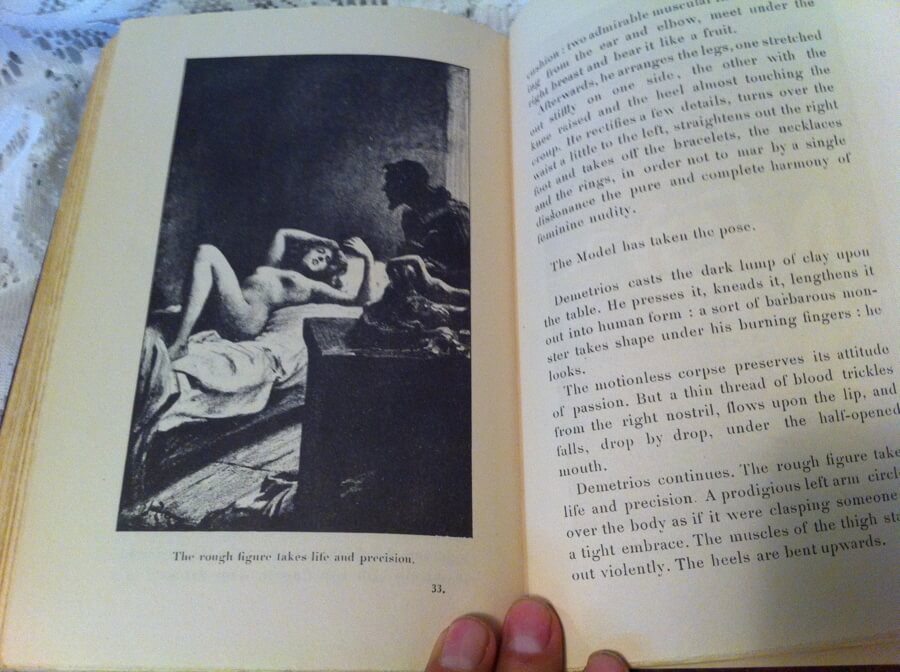
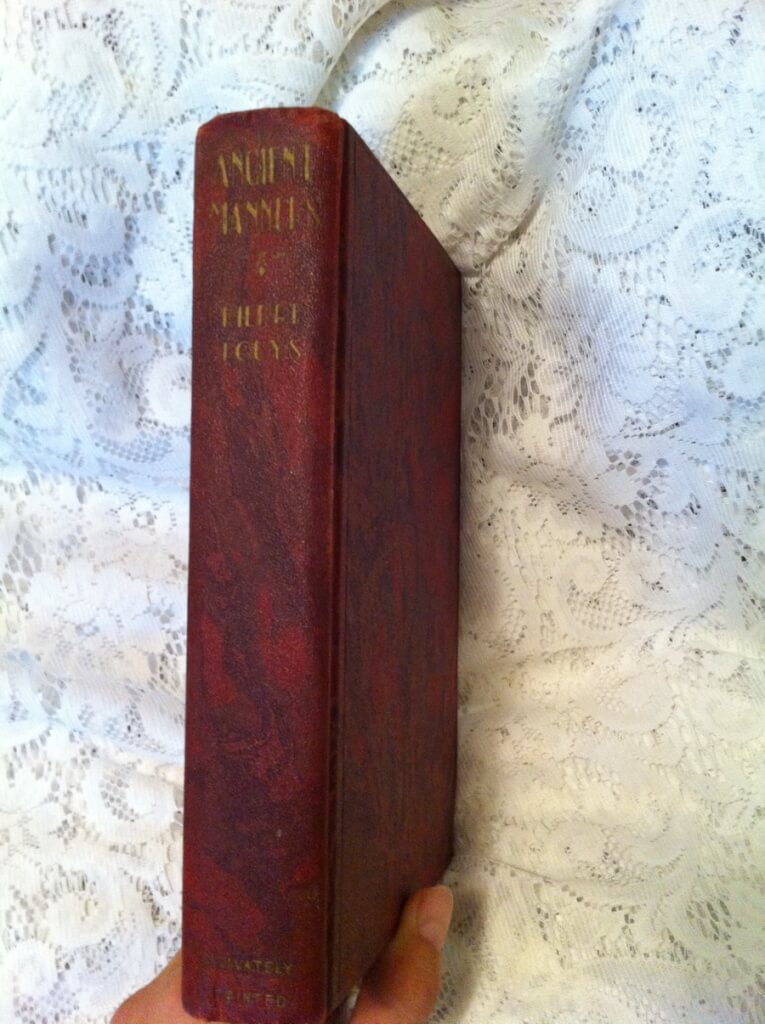 Ancient Manners, Pierre Louys (Privately printed for Subscribers only, Paris, nd. [c. 1920] ) 9.25" X 6", xvi 412pp, hardbound in marbled simulated leather cloth, edges deckled. Very good condition. Stated one of 1000, unnumbered. Owner's signature on front pastedown "E. D. York | Feb. 29, 1944." Pierre Louys (1870 - 1925) was a French poet and writer, most renowned for lesbian and classical themes in some of his writings. He is known as a writer who "expressed pagan sensuality with stylistic perfection." "Aphrodite: mæurs antiques" (Ancient Manners) is a "libertine" story set in ancient Alexandria. Highlights include the loves of Chrysis, an orgy banquet ending in the crucifixion of a slave, the love of two young musician girls and the festivals of Aphrodite. This edition states "This Translation of Ancient Manners was executed on the Printing Presses of Charles HERISSEY, at Evereux, (France), for Mr. Charles CARRINGTON, Paris, Bookseller et Publisher, and is the only complete English version extant." This is obviously a pirated copy of that edition.
Ancient Manners, Pierre Louys (Privately printed for Subscribers only, Paris, nd. [c. 1920] ) 9.25" X 6", xvi 412pp, hardbound in marbled simulated leather cloth, edges deckled. Very good condition. Stated one of 1000, unnumbered. Owner's signature on front pastedown "E. D. York | Feb. 29, 1944." Pierre Louys (1870 - 1925) was a French poet and writer, most renowned for lesbian and classical themes in some of his writings. He is known as a writer who "expressed pagan sensuality with stylistic perfection." "Aphrodite: mæurs antiques" (Ancient Manners) is a "libertine" story set in ancient Alexandria. Highlights include the loves of Chrysis, an orgy banquet ending in the crucifixion of a slave, the love of two young musician girls and the festivals of Aphrodite. This edition states "This Translation of Ancient Manners was executed on the Printing Presses of Charles HERISSEY, at Evereux, (France), for Mr. Charles CARRINGTON, Paris, Bookseller et Publisher, and is the only complete English version extant." This is obviously a pirated copy of that edition. -
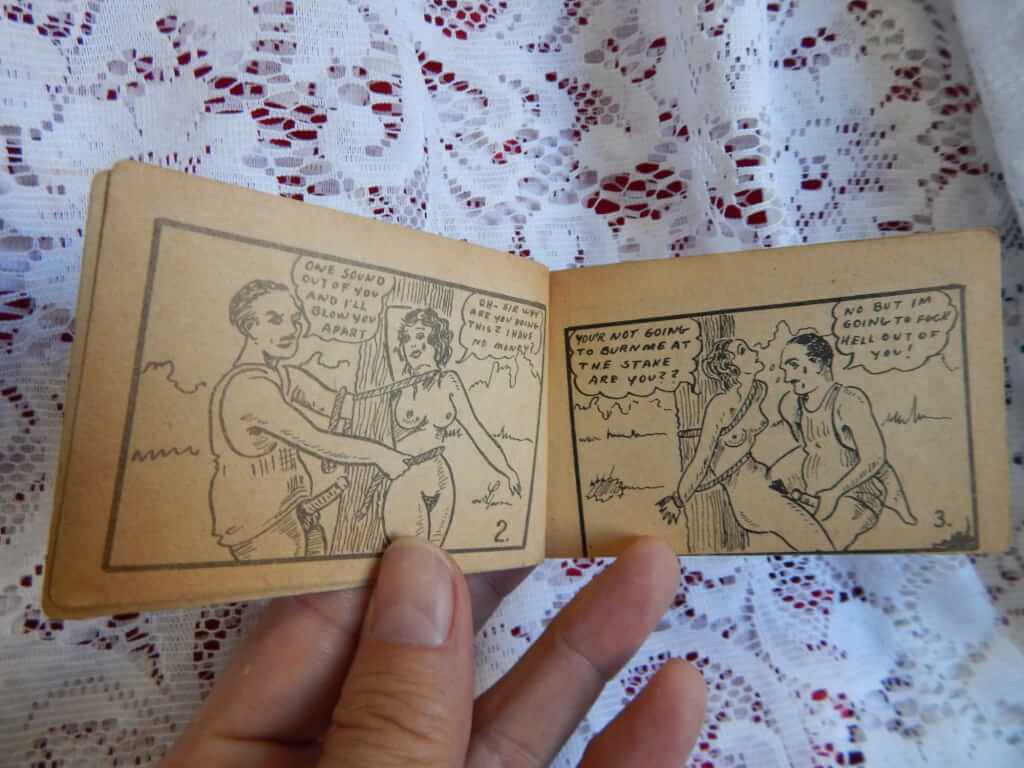
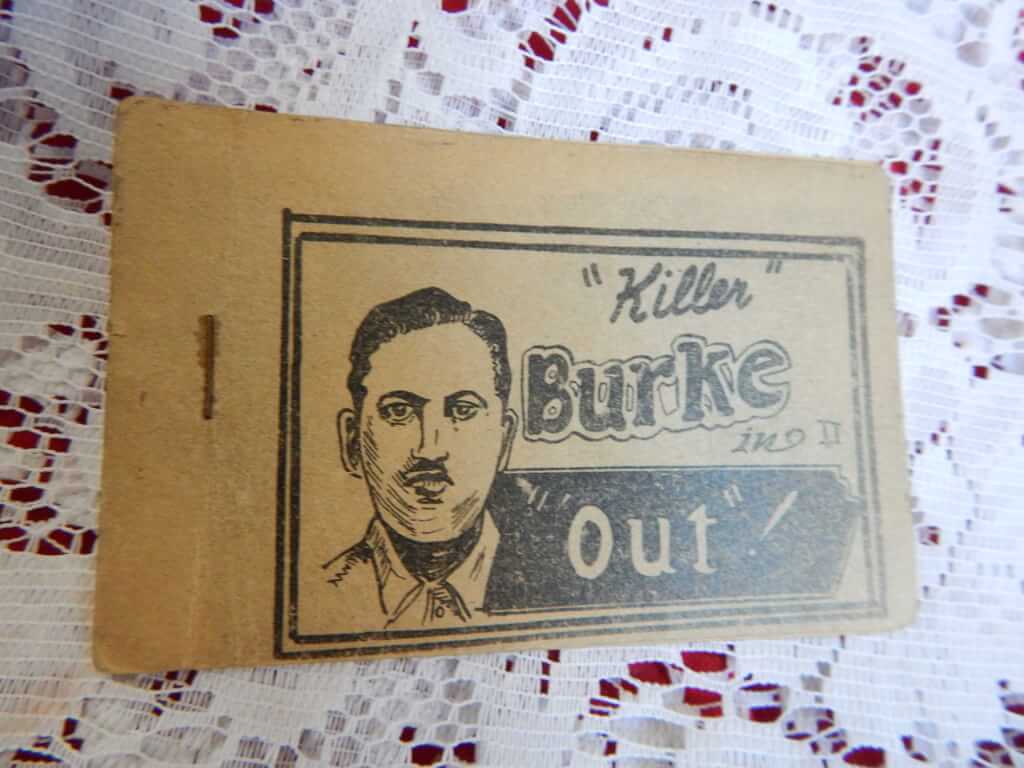 "Killer" Burke in "Out", (n.p. n.d.) 4.5" x 3", 8pp. pamphlet, stapled Tijuana bibles (also known as eight-pagers, bluesies, gray-backs, Jiggs-and-Maggie books, jo-jo books, Tillie-and-Mac books, and two-by-fours) were little pornographic comic books produced in the United States from the 1920s to the early 1960s.
"Killer" Burke in "Out", (n.p. n.d.) 4.5" x 3", 8pp. pamphlet, stapled Tijuana bibles (also known as eight-pagers, bluesies, gray-backs, Jiggs-and-Maggie books, jo-jo books, Tillie-and-Mac books, and two-by-fours) were little pornographic comic books produced in the United States from the 1920s to the early 1960s. -
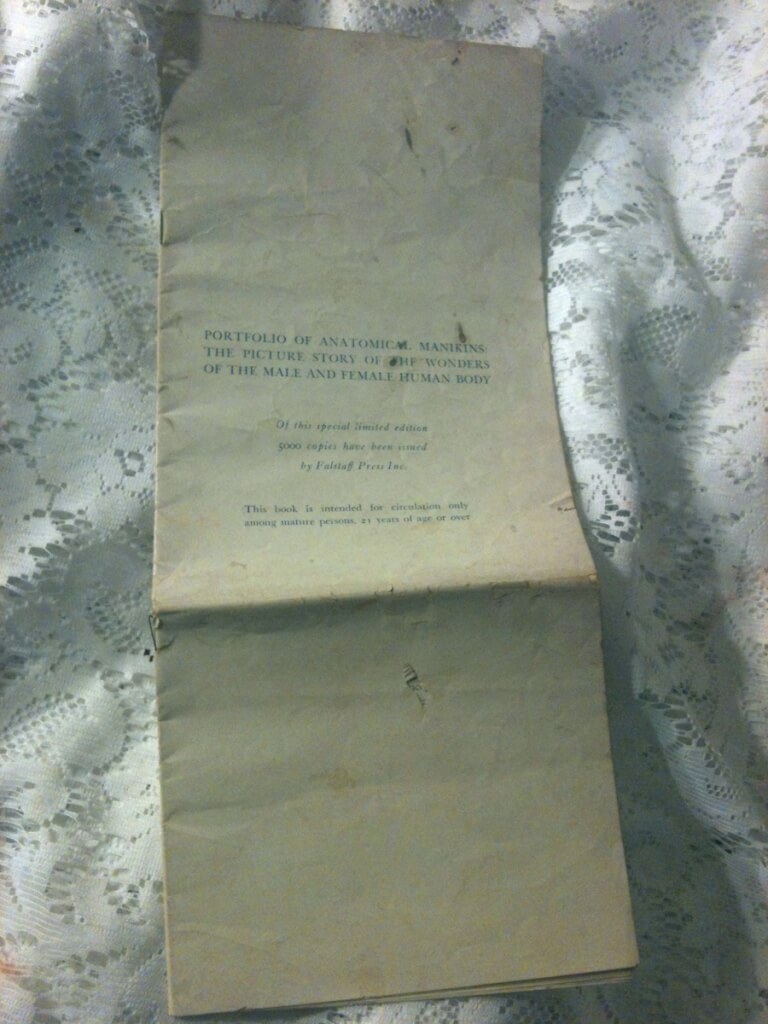
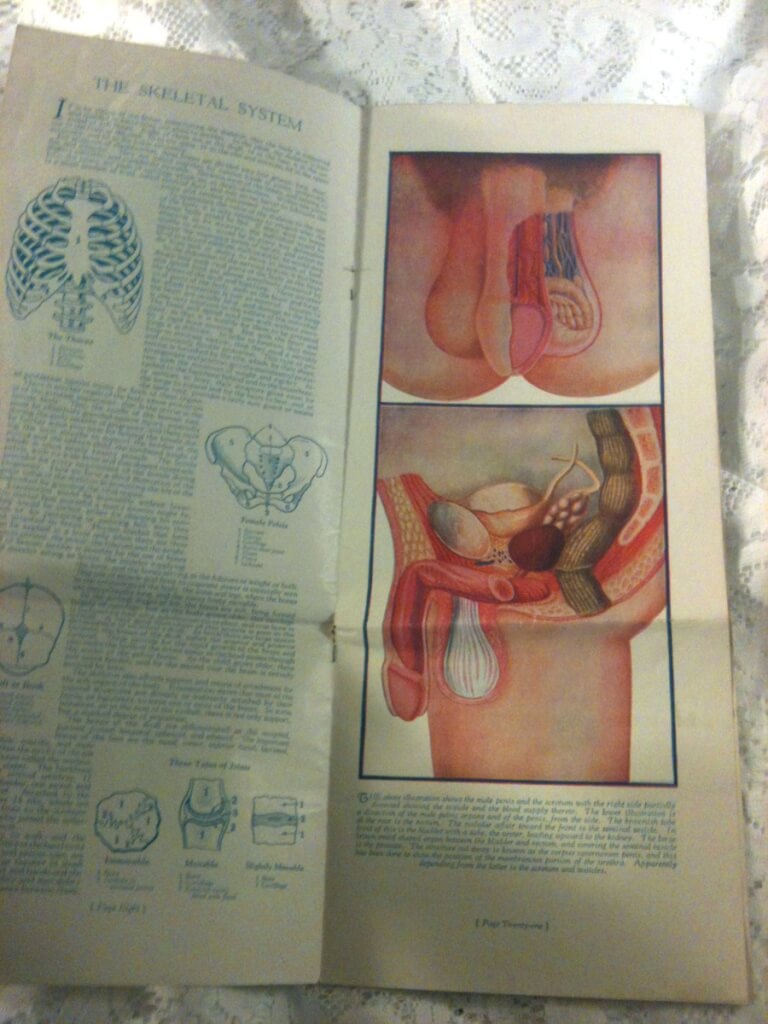 Portfolio of Anatomical Manikins: Picture Story of Body, Keller, David H., M.D. (Falstaff Press, New York, 1937) 14" X 5.75", 27pp. Pamphlet without issued DJ. Good condition for age. Originally folded to fit into dust jacket, crease present, few stains, tears and wear. Limited edition of 5000 "This book is intended for circulation only among mature persons, 21 years of age or over" Anatomical illustrations of the human body, focusing on the reproductive system and organs.
Portfolio of Anatomical Manikins: Picture Story of Body, Keller, David H., M.D. (Falstaff Press, New York, 1937) 14" X 5.75", 27pp. Pamphlet without issued DJ. Good condition for age. Originally folded to fit into dust jacket, crease present, few stains, tears and wear. Limited edition of 5000 "This book is intended for circulation only among mature persons, 21 years of age or over" Anatomical illustrations of the human body, focusing on the reproductive system and organs. -
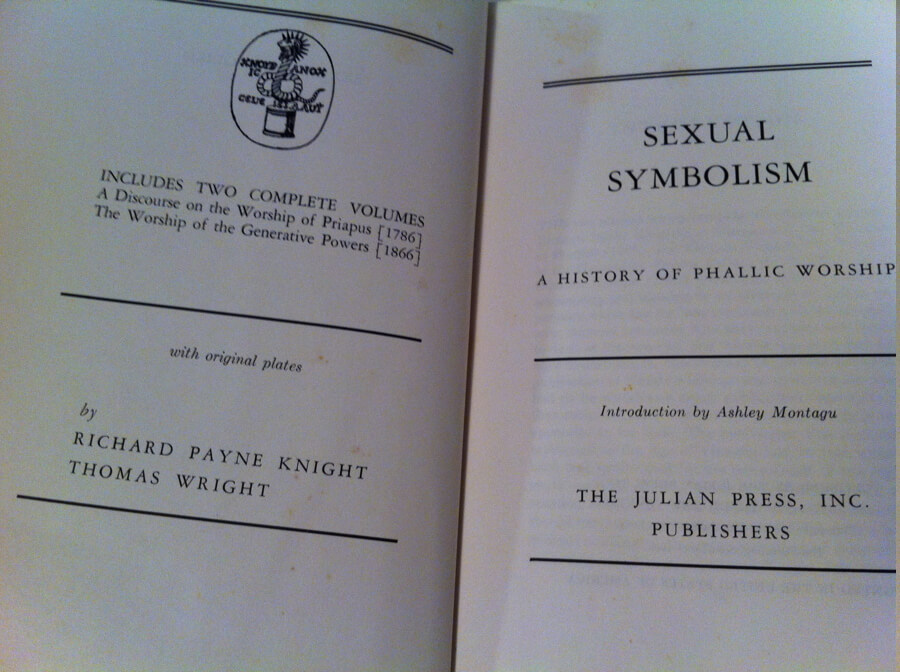
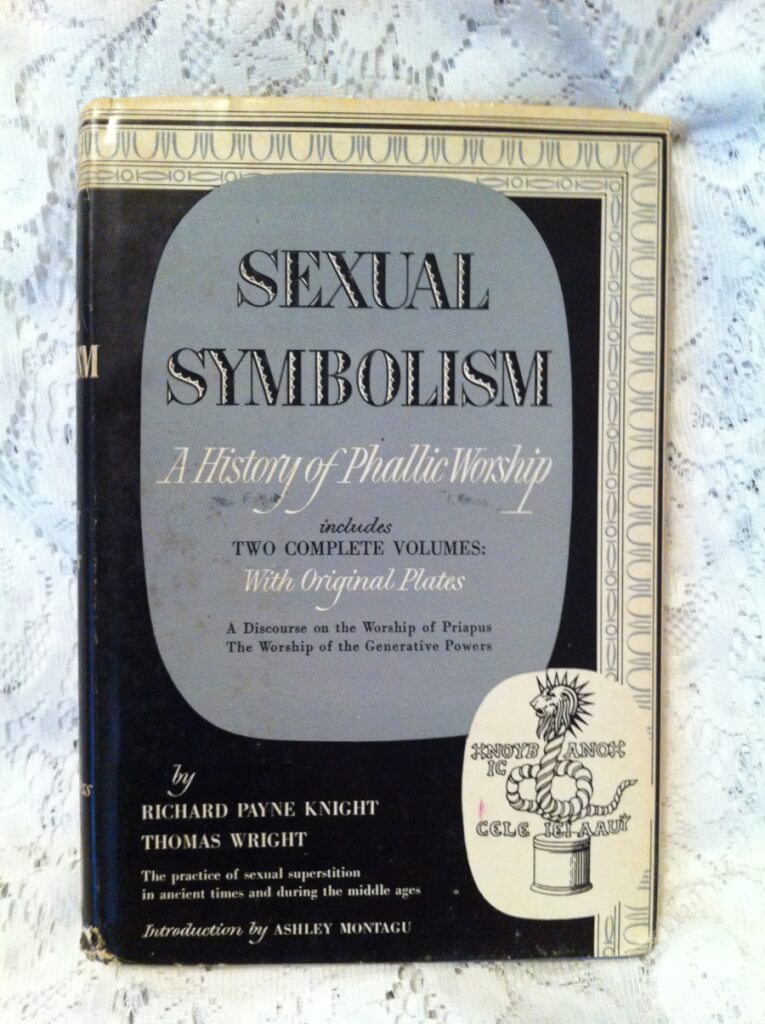 Sexual Symbolism: A History of Phallic Worship, Richard Payne Night & Thomas Wright, intro by Ashley Montagu (The Julia Press, Inc., New York, 1962) 9.5" X 6.5", 217pp + 196pp, hardbound with dustjacket, good condition for age, a few tears in the dustjacket A reprinting of two earlier works with an introduction by Ashley Montagu. The works are: "A Discourse on the Worship of Priapus, and it's connection with the mystic theology of the ancients" [1786] by Richard Payne Knight "to which is added an account of the remains of the worship of priapus lately existing at isernia in the kingdom of Naples by Sir William Hamilton, K.B." and "The Worship of the Generative Powers" [1866] by Thomas Wright
Sexual Symbolism: A History of Phallic Worship, Richard Payne Night & Thomas Wright, intro by Ashley Montagu (The Julia Press, Inc., New York, 1962) 9.5" X 6.5", 217pp + 196pp, hardbound with dustjacket, good condition for age, a few tears in the dustjacket A reprinting of two earlier works with an introduction by Ashley Montagu. The works are: "A Discourse on the Worship of Priapus, and it's connection with the mystic theology of the ancients" [1786] by Richard Payne Knight "to which is added an account of the remains of the worship of priapus lately existing at isernia in the kingdom of Naples by Sir William Hamilton, K.B." and "The Worship of the Generative Powers" [1866] by Thomas Wright












